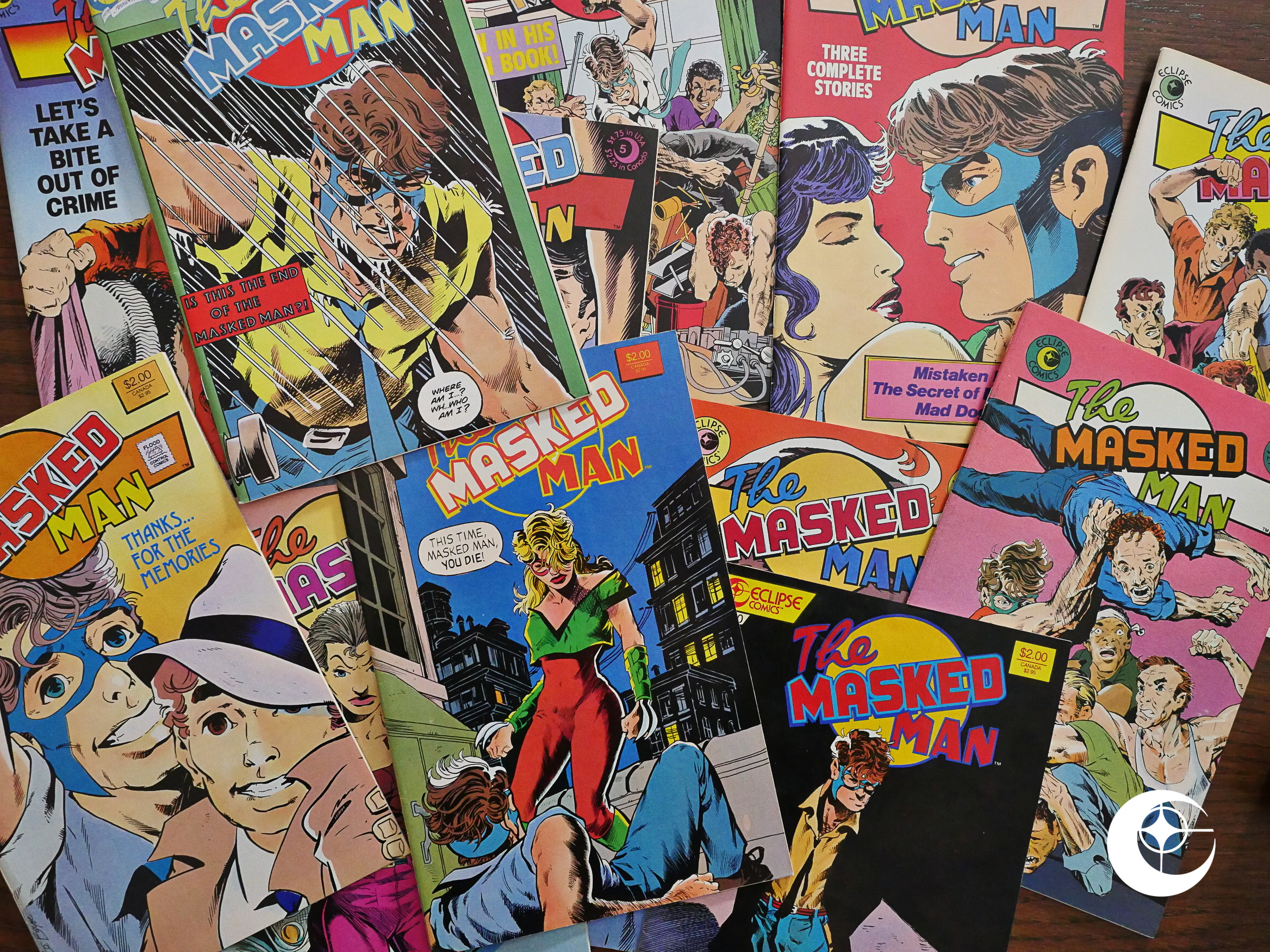Twisted Tales (1982) #1-8, Twisted Tales (1984) #9-10, The Twisted Tales of Bruce Jones (1986) #1-4, Twisted Tales (1987) #1 by Bruce Jones et al.
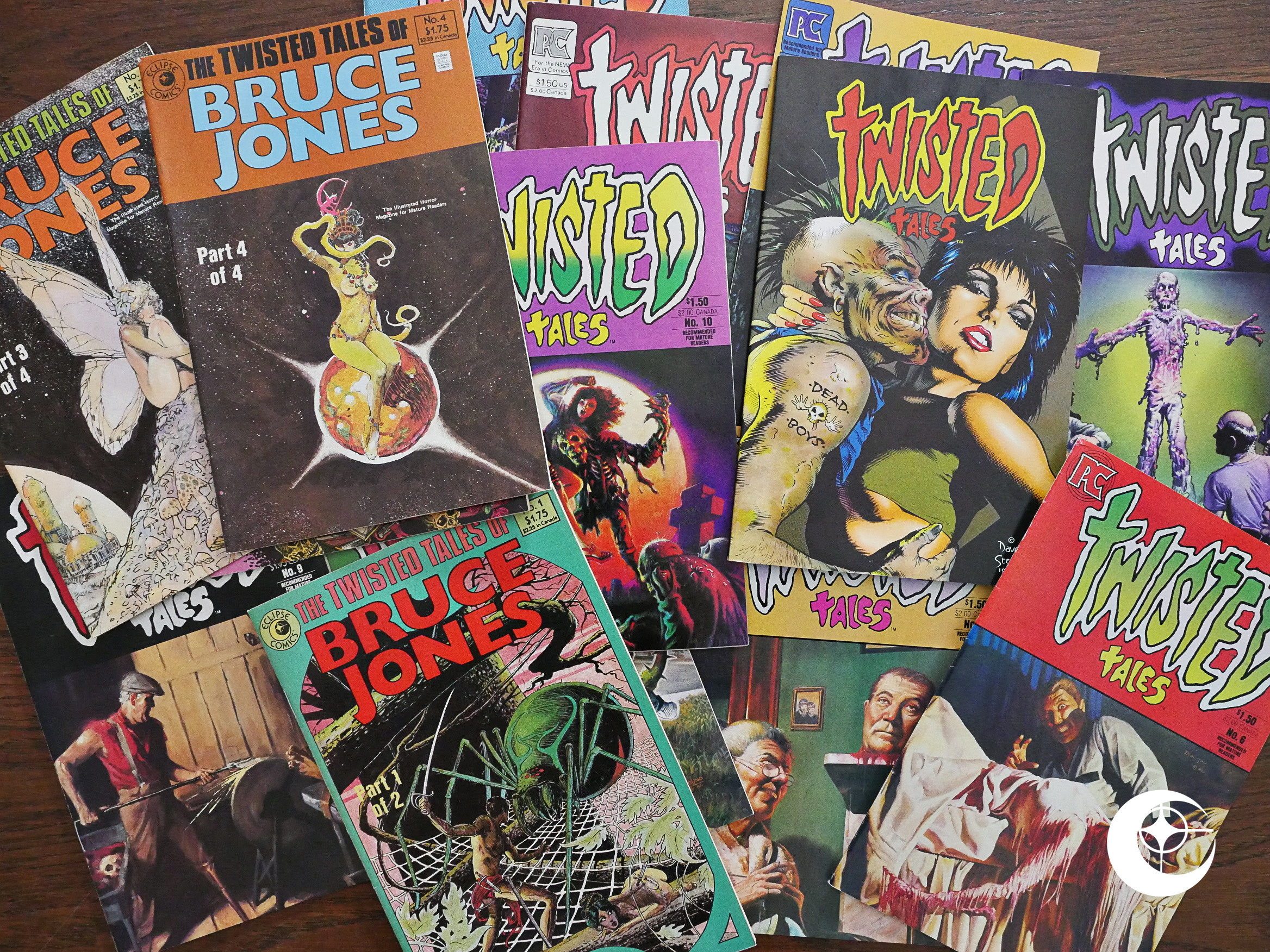
Of all these Eclipsish comics, Twisted Tales my be the ones I remember best from my early teens. Of course, the eight first issues were published by Pacific Comics before they went bankrupt, so it’s fair to say that Pacific was a more memorable publisher than Eclipse, and I should have done a blog series about them instead.
D’oh!
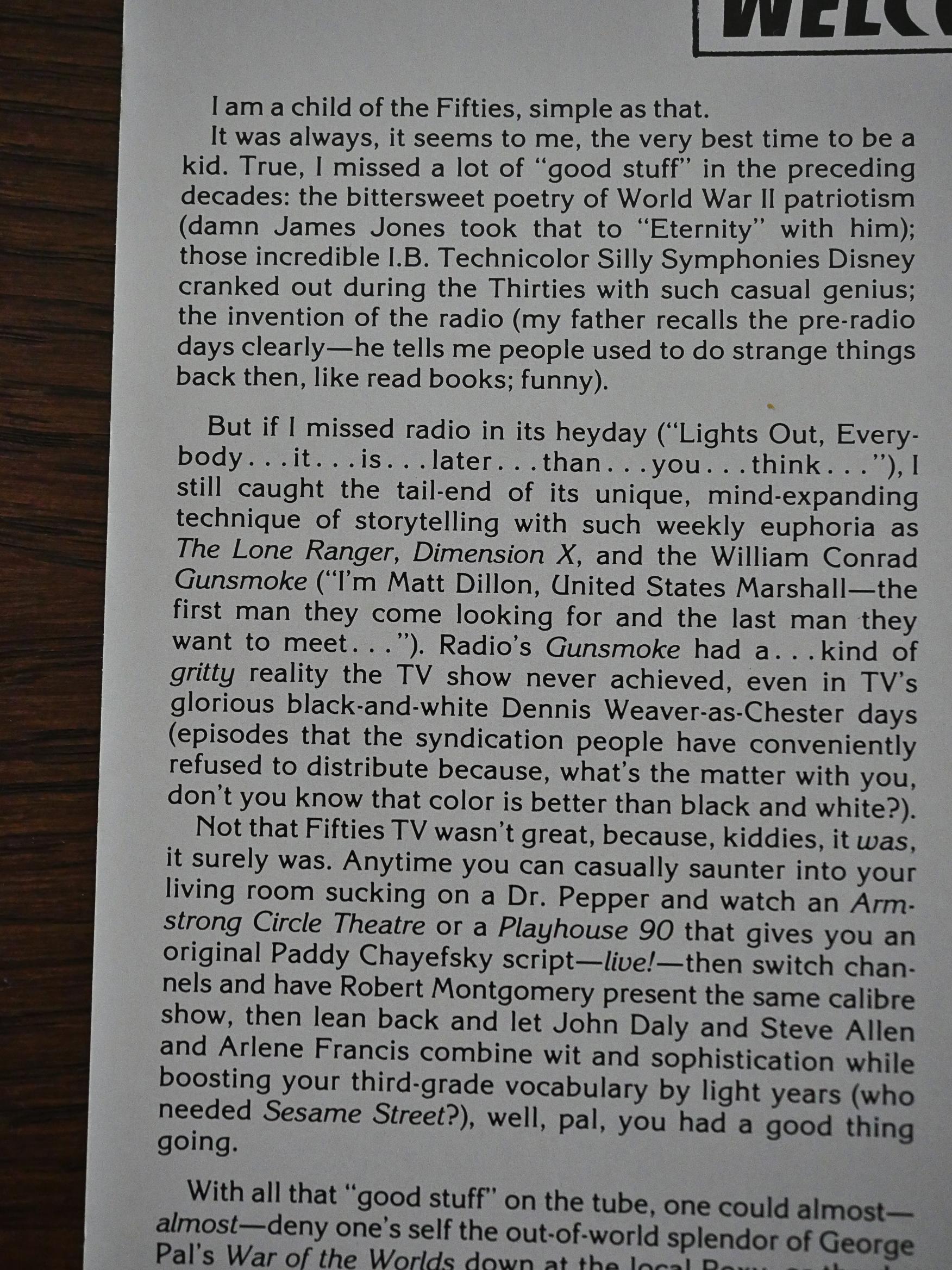
In the first issue, writer and co-editor Bruce Jones provides a background to what he’s attempting to do here. Basically: Do horror in a way that reminds him of what it was like to experience horror stuff when he was growing up in the 50s.
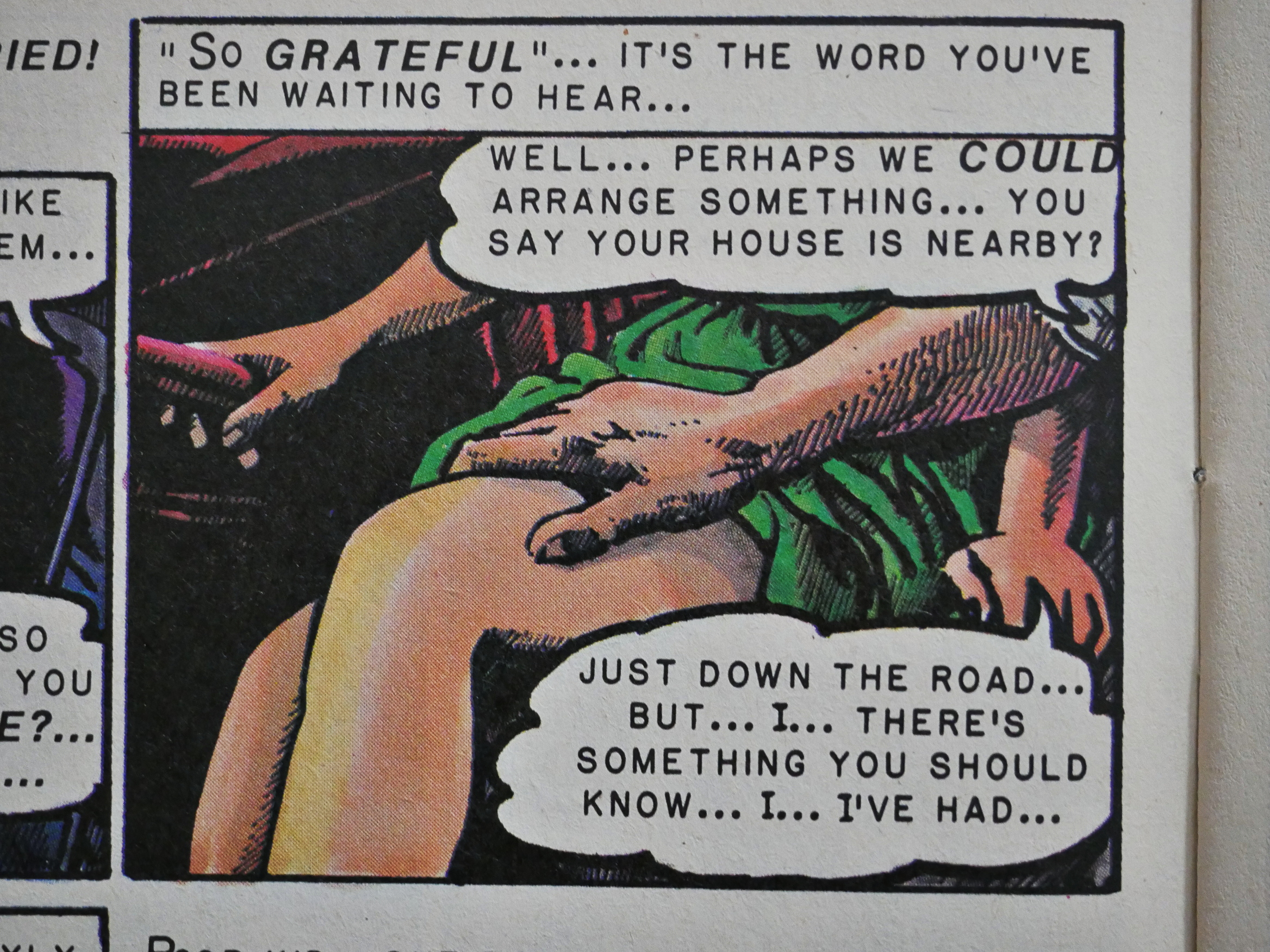
While EC comics are an obvious touch-stone here (down to the lettering Richard Corben uses in the first story of the first issue (but didn’t he use that style anyway around this time?)), we’re in the 80s, and things have a more psychosexual tint to them than when Al Feldstein wrote horror comics in the 50s.
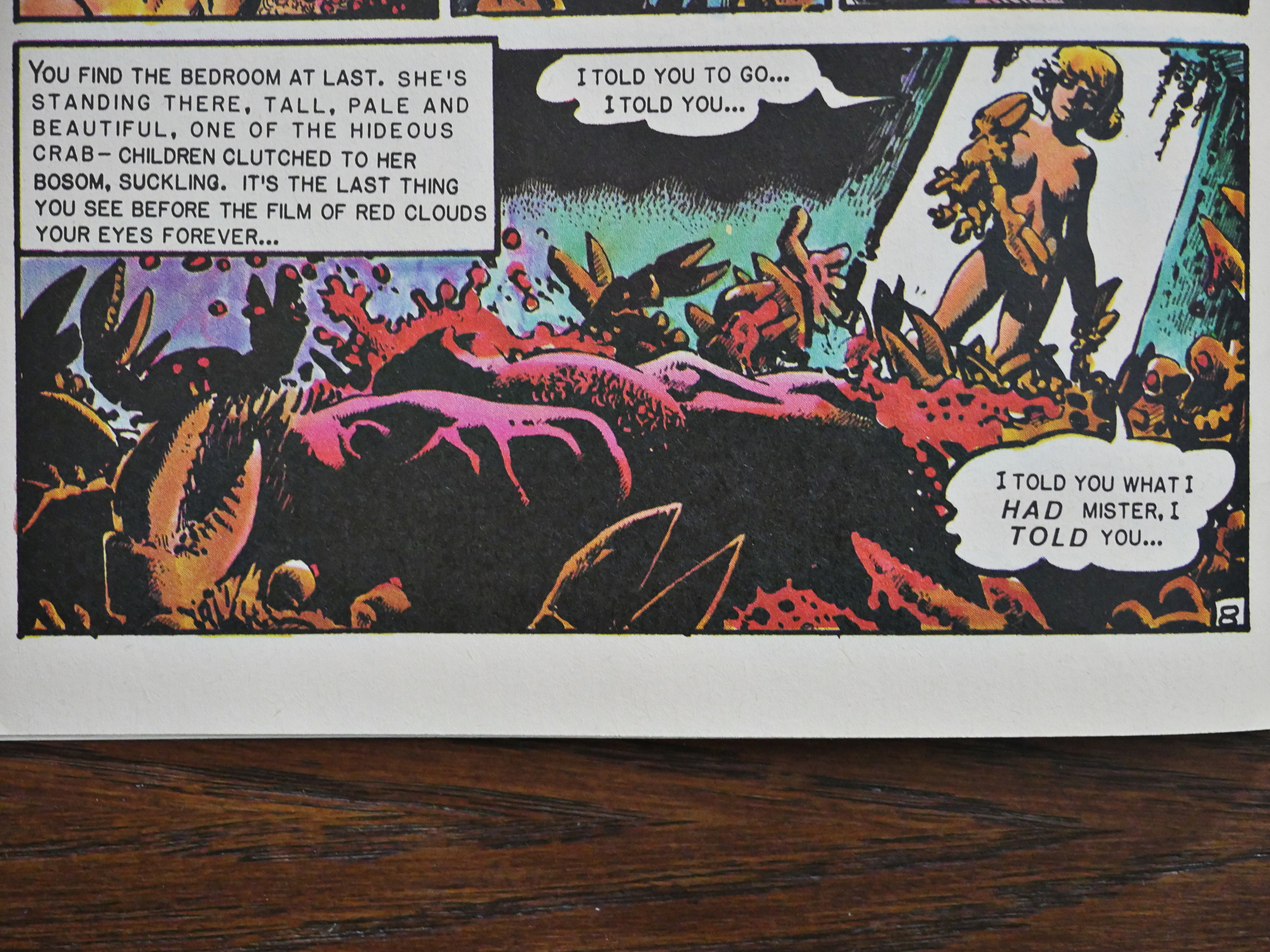
And that the punchline to the story, so don’t display it if you haven’t read the story, which turned out to be pretty much everybody’s favourite, according to the letter columns. It’s called infected, and you see, she’s saying that she had… and then we see that she has…
Yes, it’s a very silly joke, but mixing that joke in with Corben’s awesomely gruesome artwork, it’s exhilarating. You really feel that Jones has honed his horror craft and is extremely enthusiastically throwing everything horrible he knows at the reader.
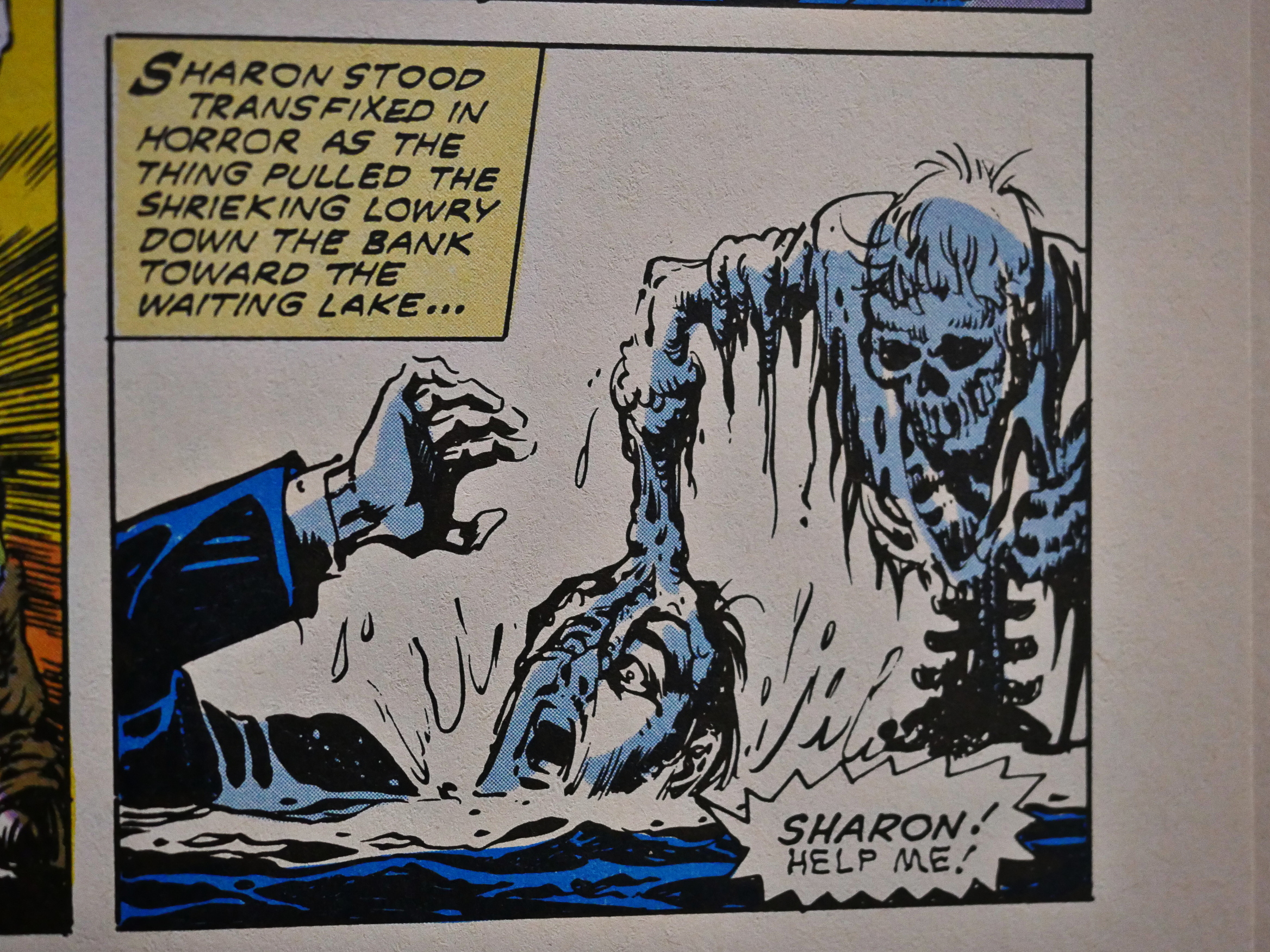
I had expected a bunch of Warren artists to show up here, but only a small handful, like Alfredo Alcala drops by. It’s the most traditionally EC story of them all, perhaps.
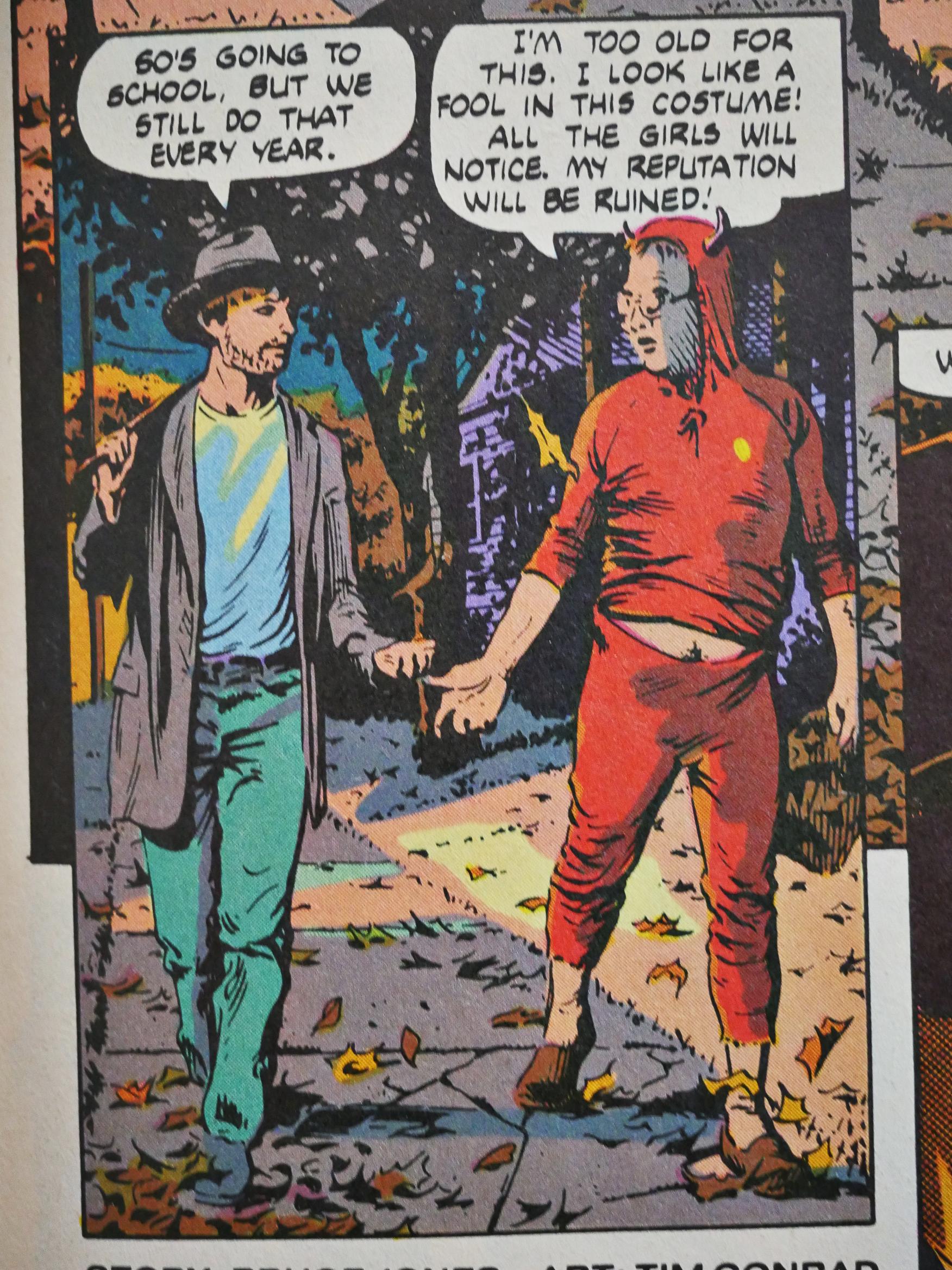
Tim Conrad provides the artwork to this slow burner: Everything’s wrong throughout, and resolves itself perfectly within its horror universe.
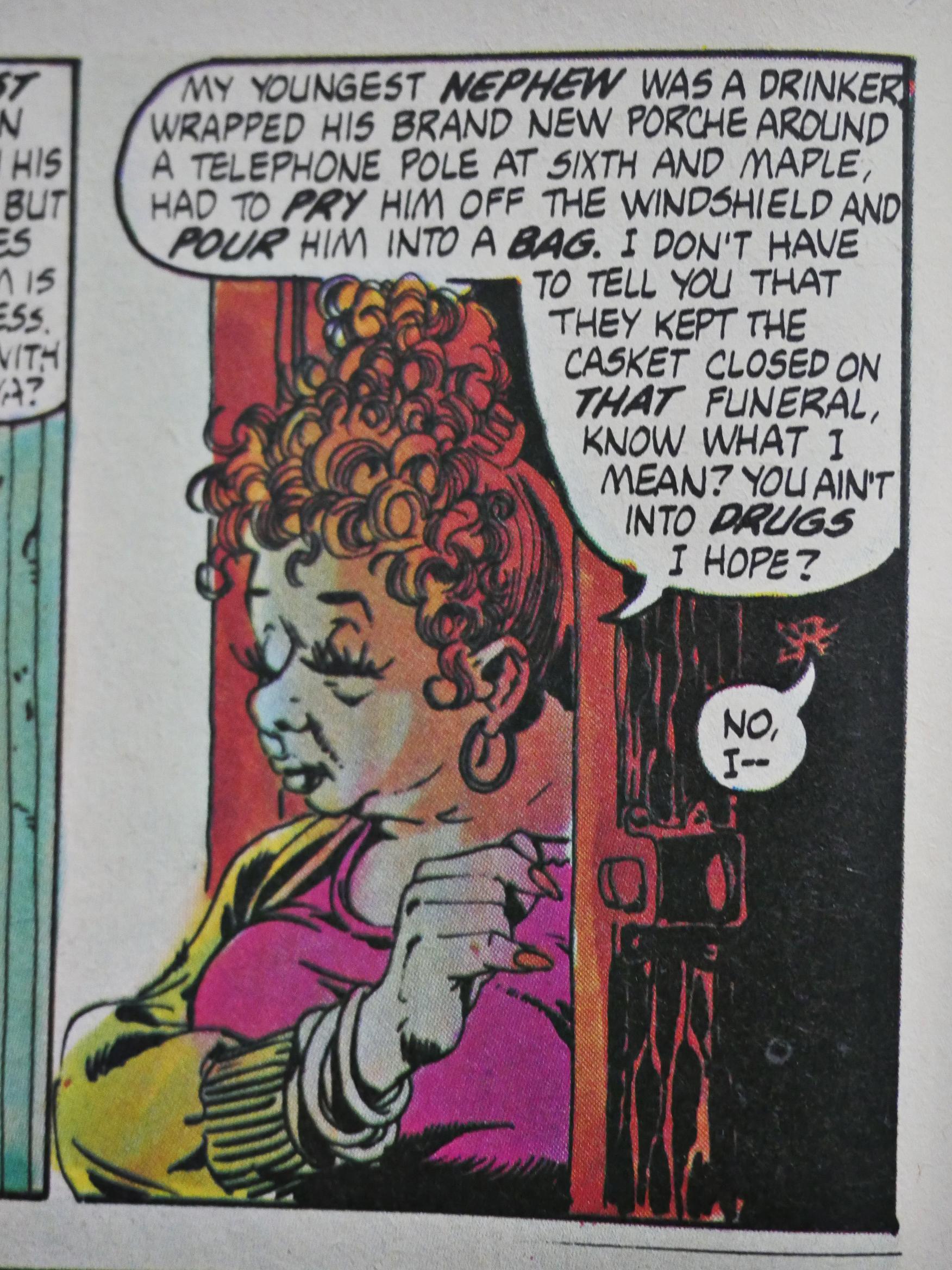
If there’s one problem Jones has, is that he’s a bit prolix at times. But he does have a good ear. It’s seldom grating.
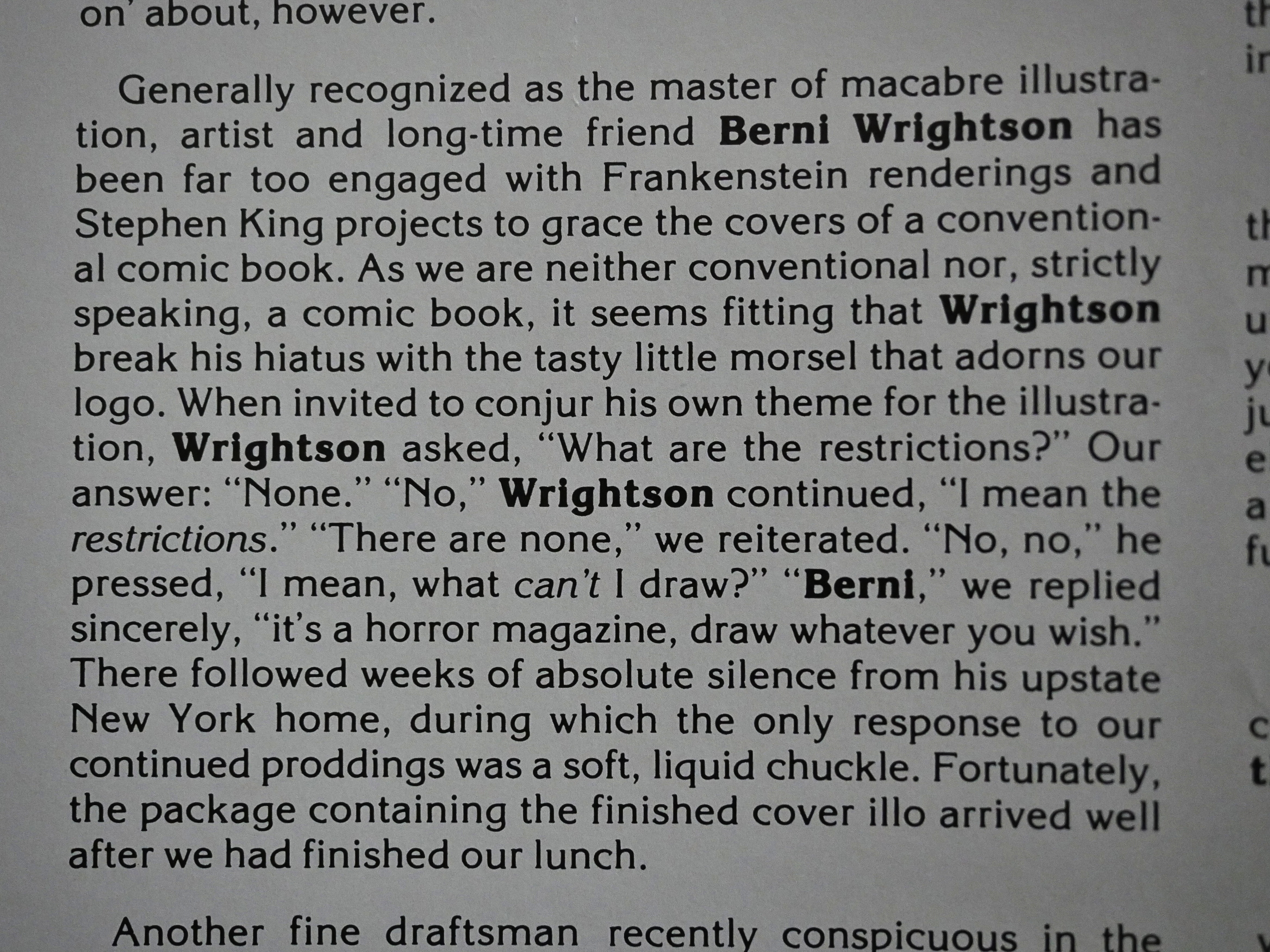
In the second issue, Jones explains that there are no restrictions here on what the artists can draw, because this is a horror magazine for mature readers. Wrightson takes him up on it and does perhaps the most grisly cover of its run. But Jones overstates the case: Of course there are limitations to what he could have drawn. If he’d turned in something with severed erect penises, then that would have been a no-go. Decapitated heads is just good clean fun, you know.
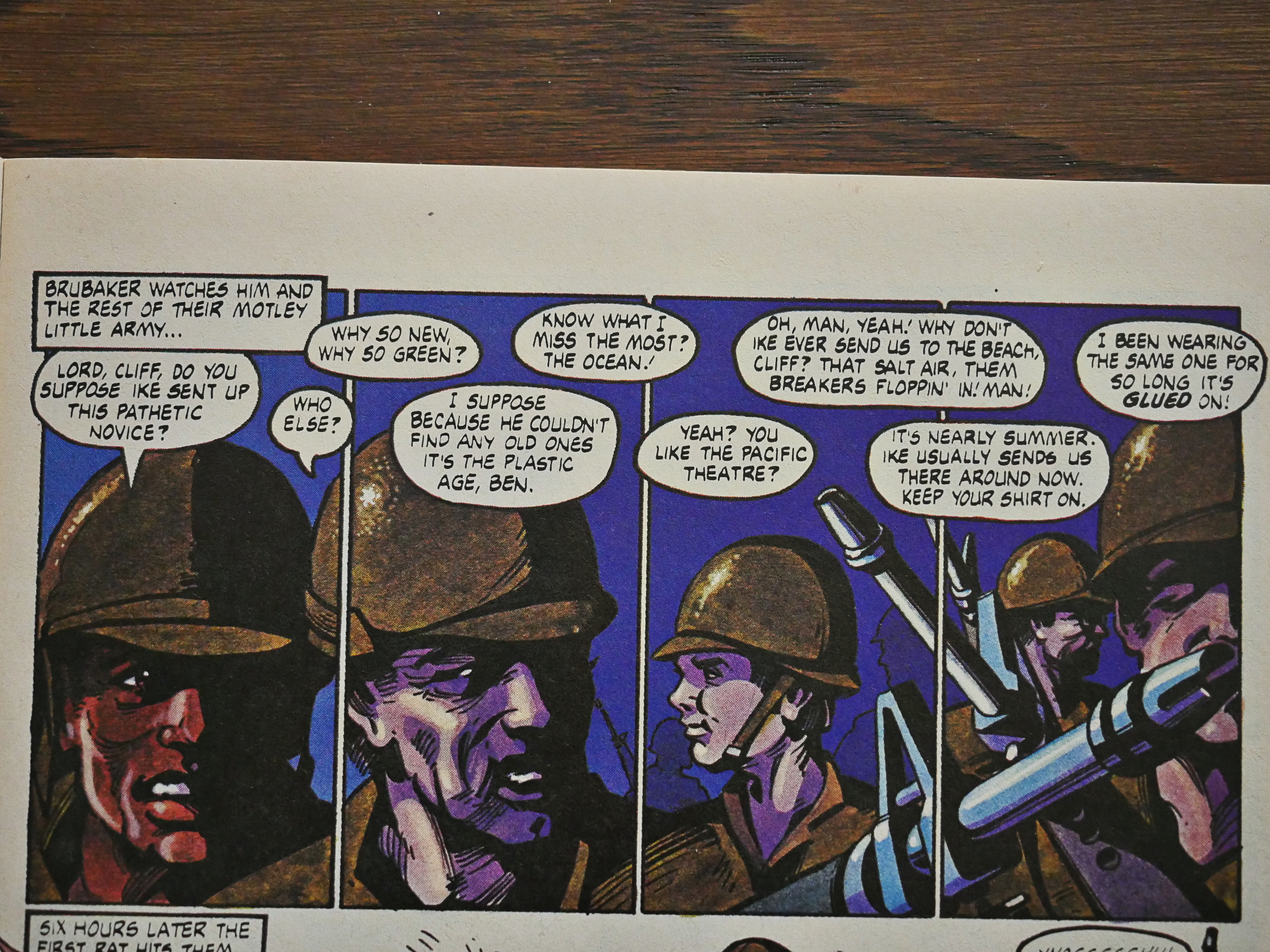
The first issue had used traditional flat-ish colour separations, while the rest use laser scanning for the colours, which allows artists like Ken Steacy here to turn in fully painted stories.
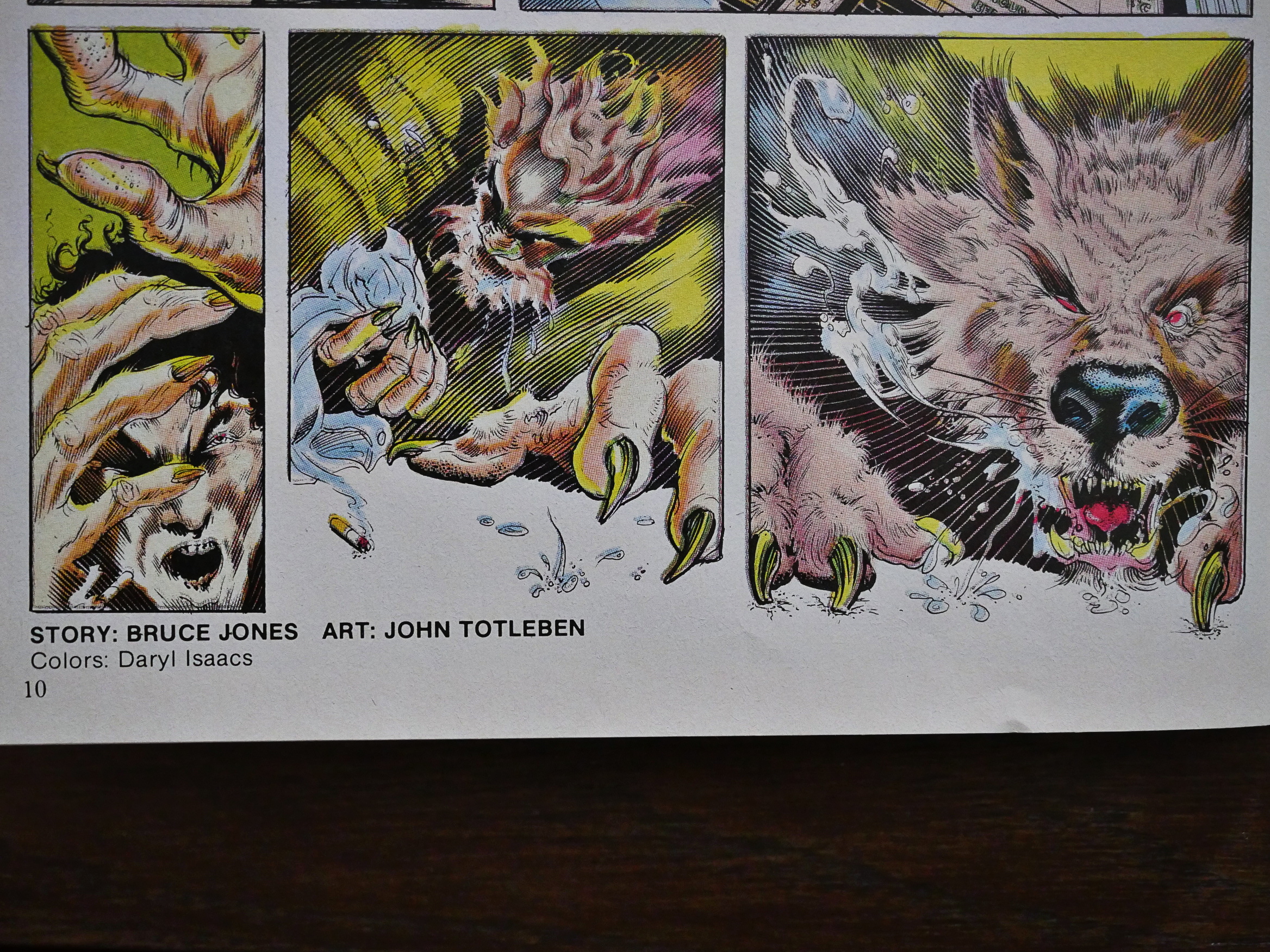
Hey! John Totleben! Was this after Swamp Thing? Hm… It’s a fun little ditty.
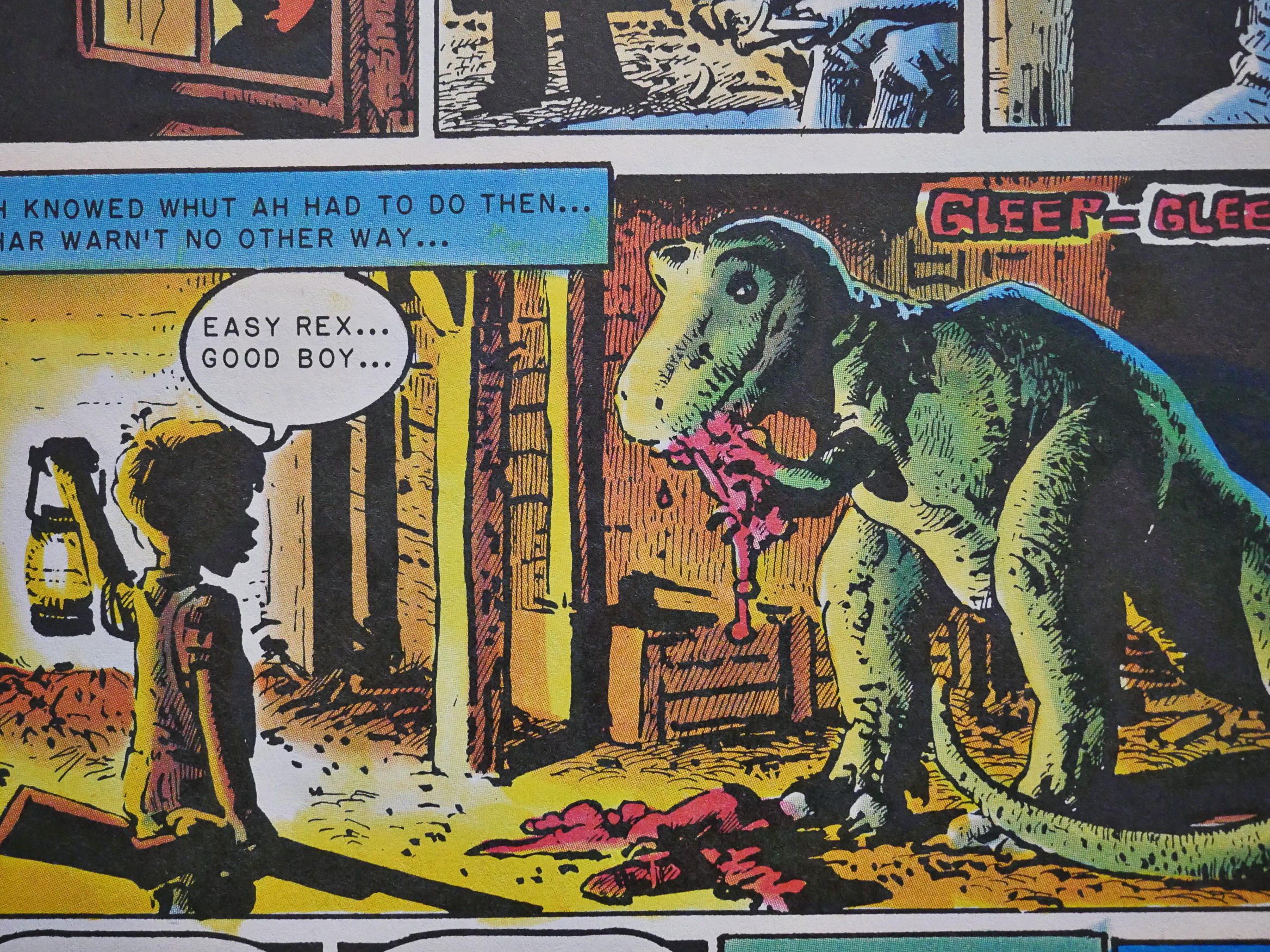
Did I mention how much I remember of these stories from when I was a kid? I must have read them a gazillion times. Here’s the second and final story with Richard Corben artwork. Still a pretty harrowing story now.
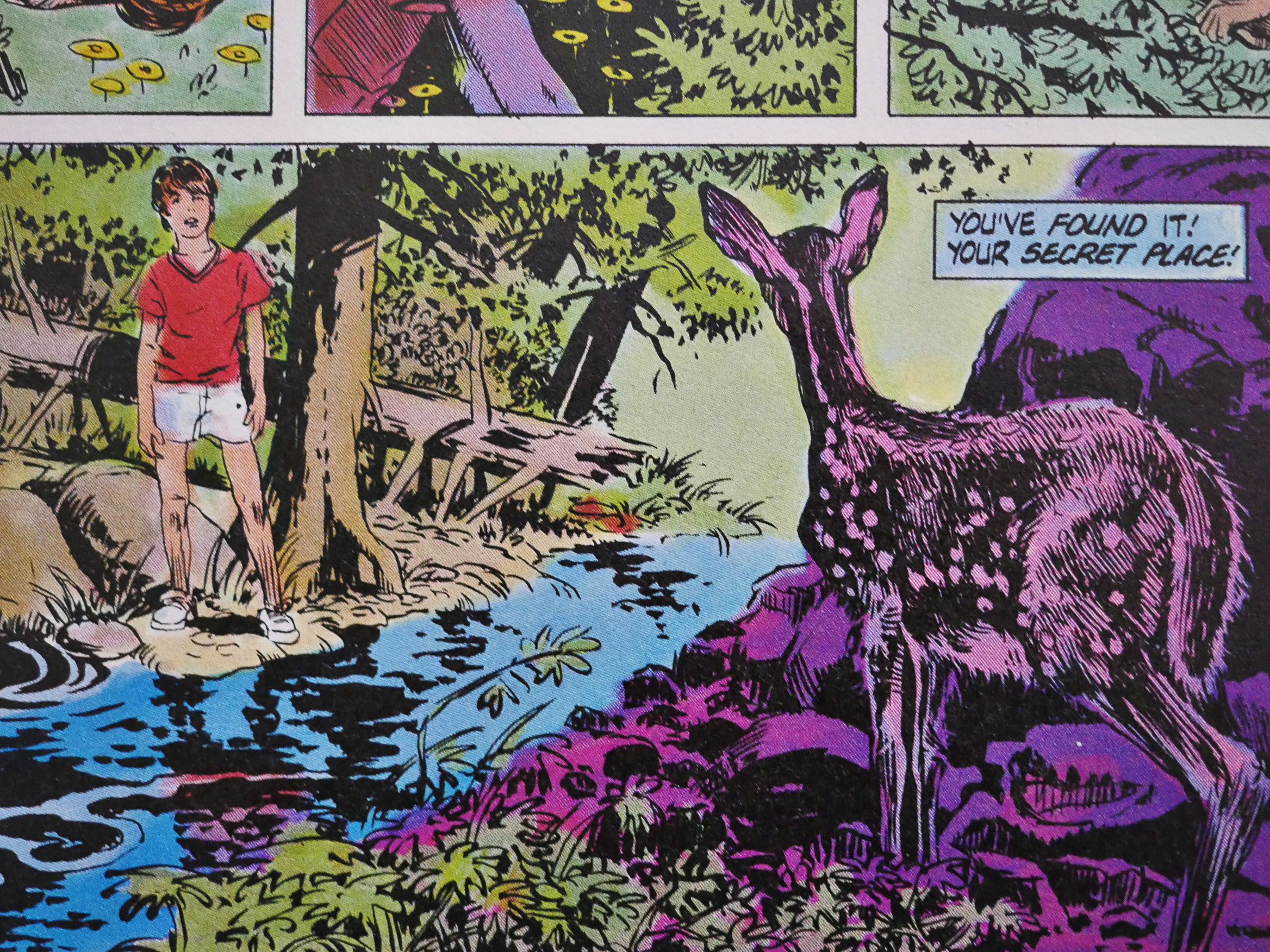
Bruce Jones does the artwork to a single one of the stories, and very nice it is indeed.
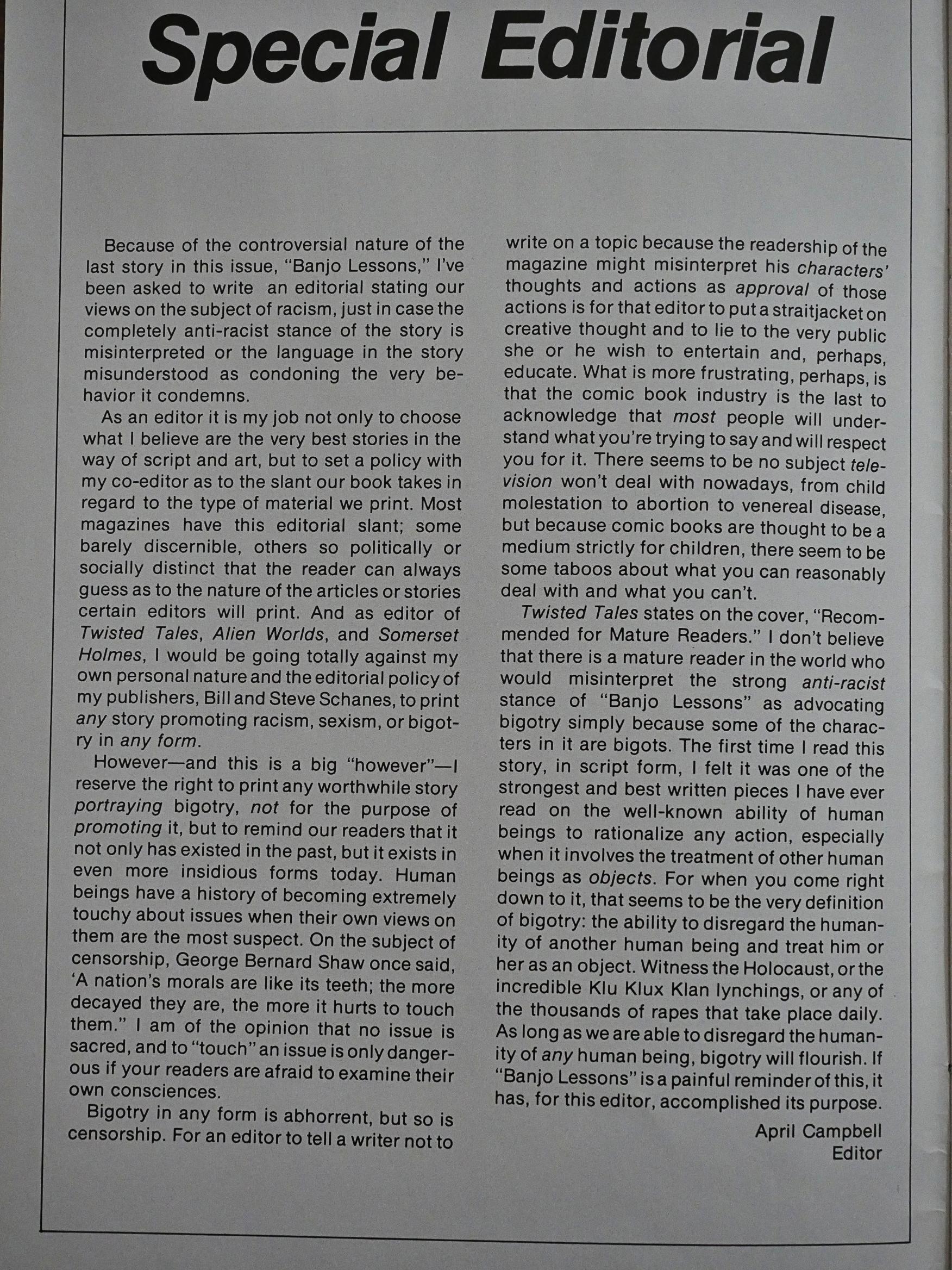
And then we come to the biggie: Banjo Lessons. The issue opens with co-editor April Campbell basically saying that, no matter how this is going to look, Banjo Lessons is not racist. It’s a pretty defensive way to open, but…
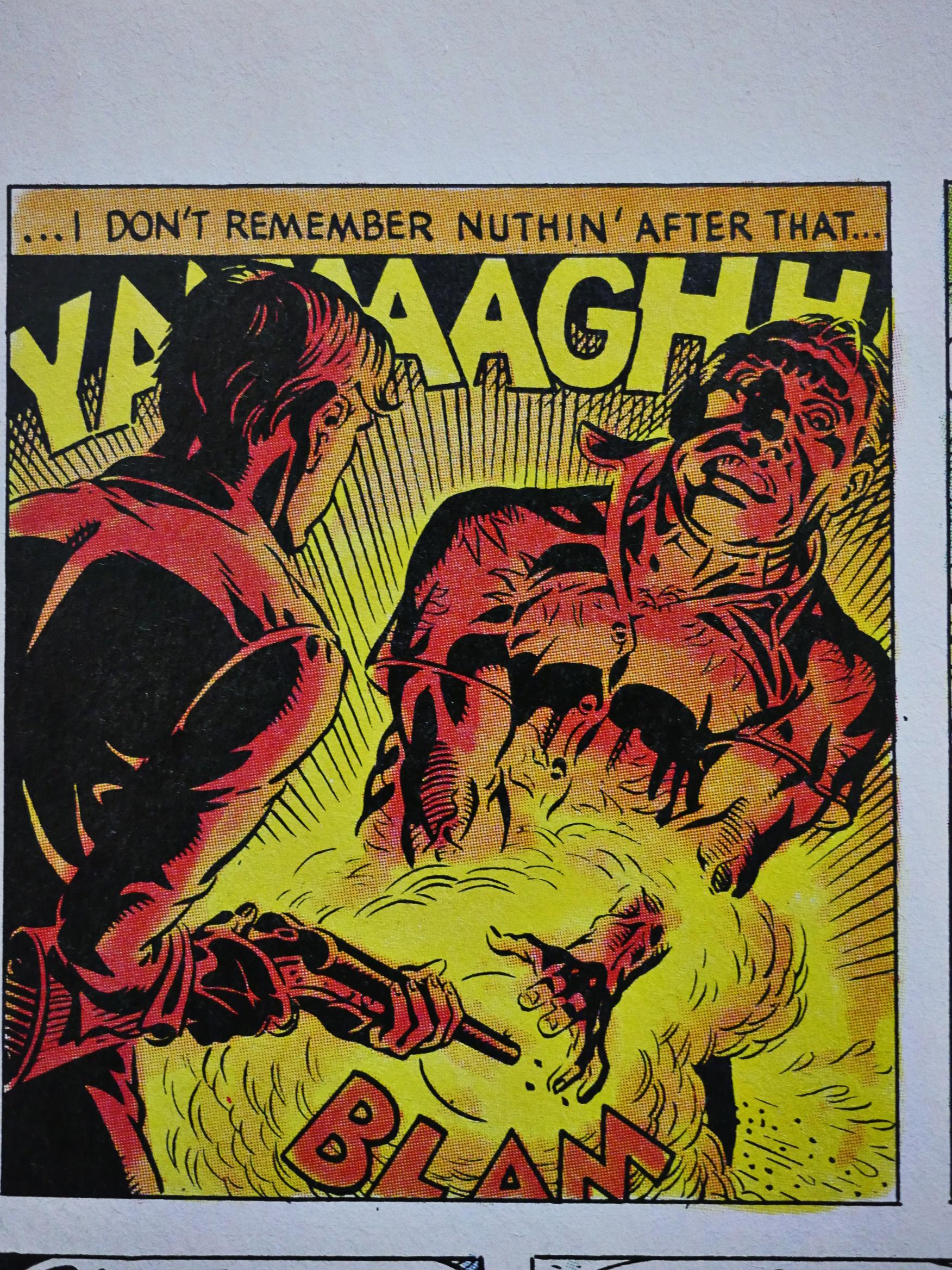
OK, here’s the story, which I’m not going to show the most offending imagery from. The artwork’s by Rand Holmes, and he lovingly and gruesomely renders it in his best Al Williamson/Wally Wood mode. No, that panel up there isn’t what Campbell was referring to.
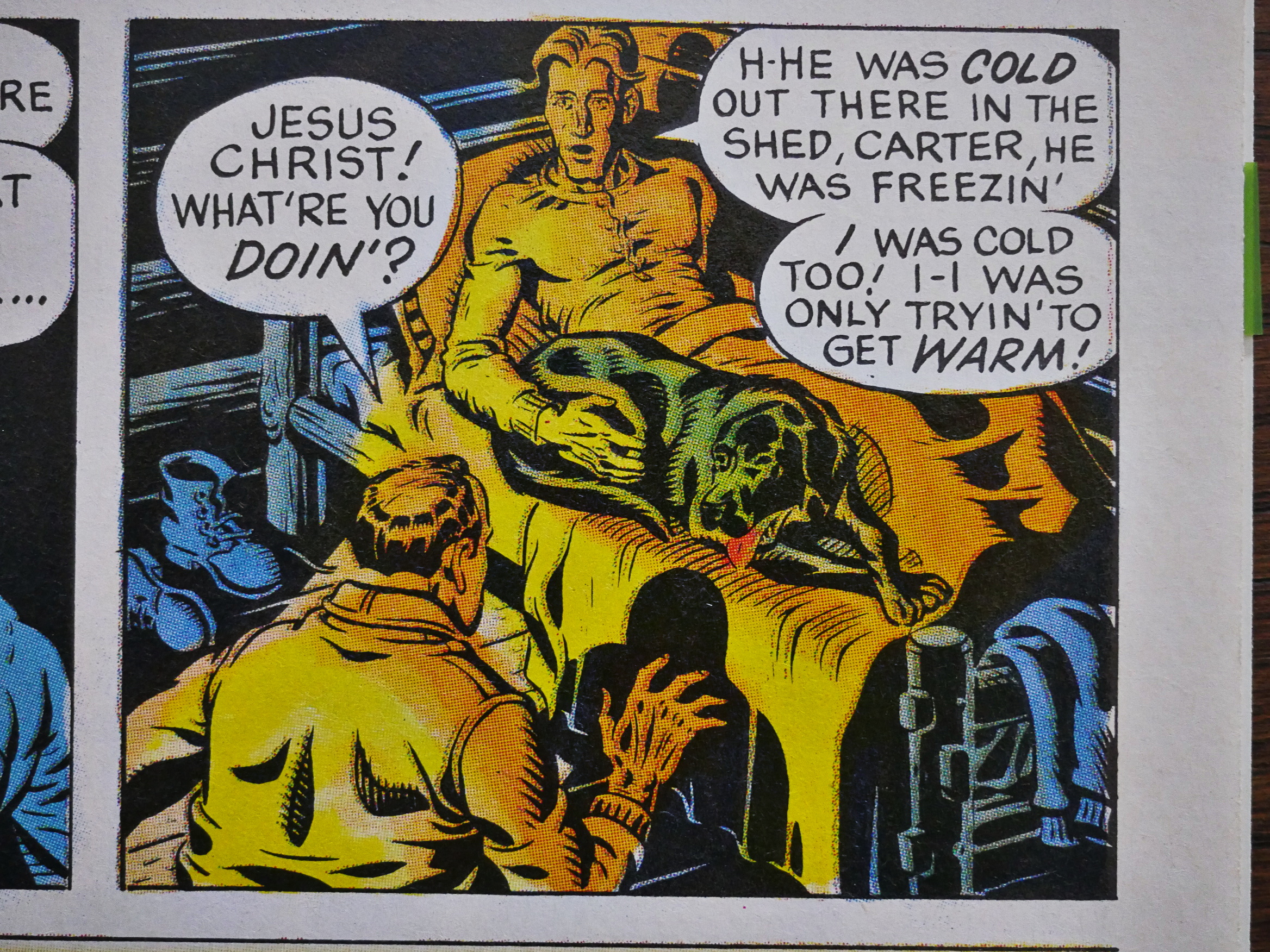
I felt reading it this time, that Campbell was giving away some of the shock value of the story by inducing a certain interpretation to panels like the above, that might otherwise not be understood until a second read-through. But, of course, I remembered it all from when I read it last 30 years ago, so…
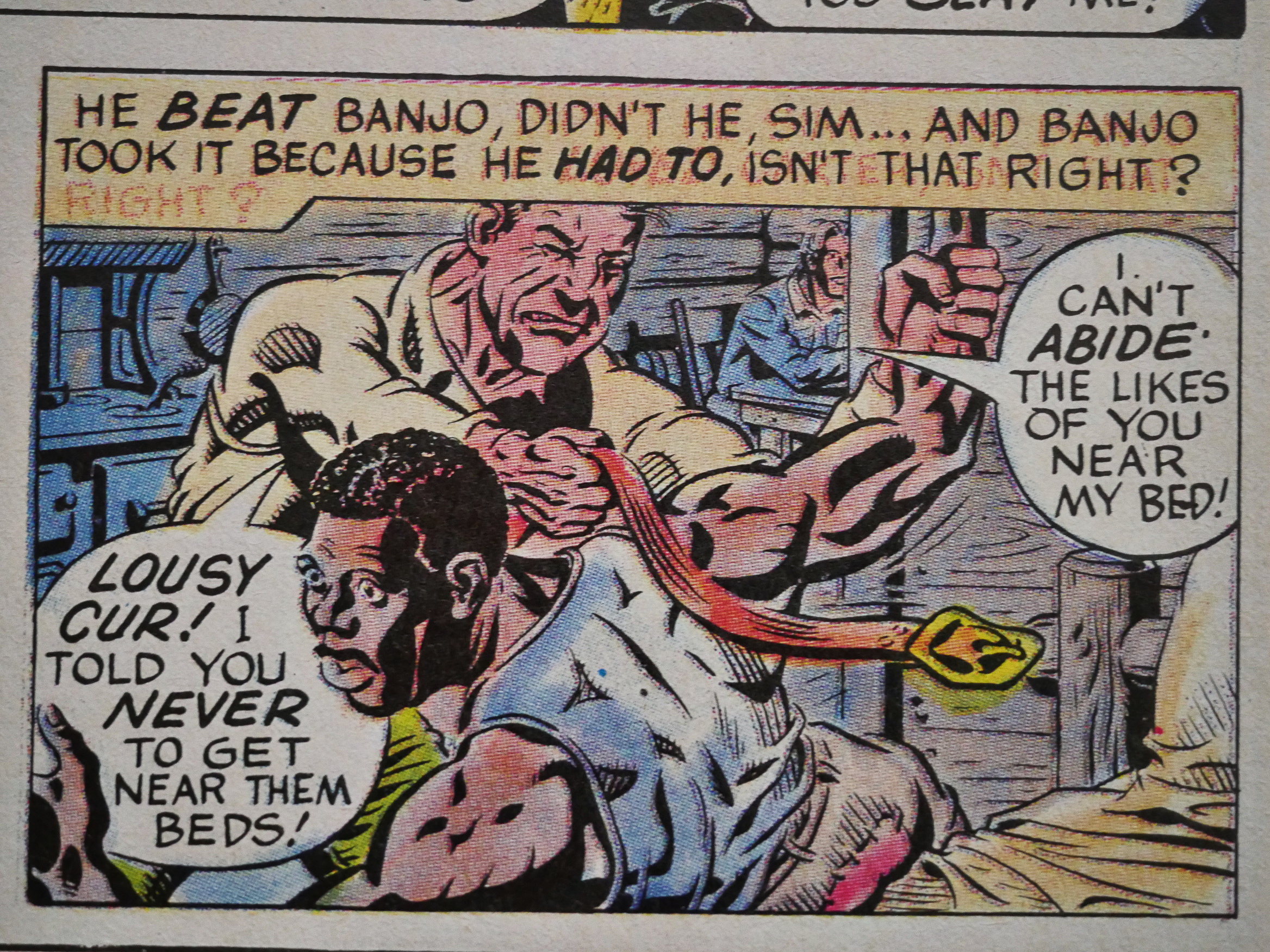
But the denouement (a few panels after this one) was still as shocking and revolting as ever. Perhaps even more so now.
Of all the pieces in Twisted Tales, it’s the only one that made me nauseous now.
(Hm… has something been erased in that caption and overwritten with something else?)
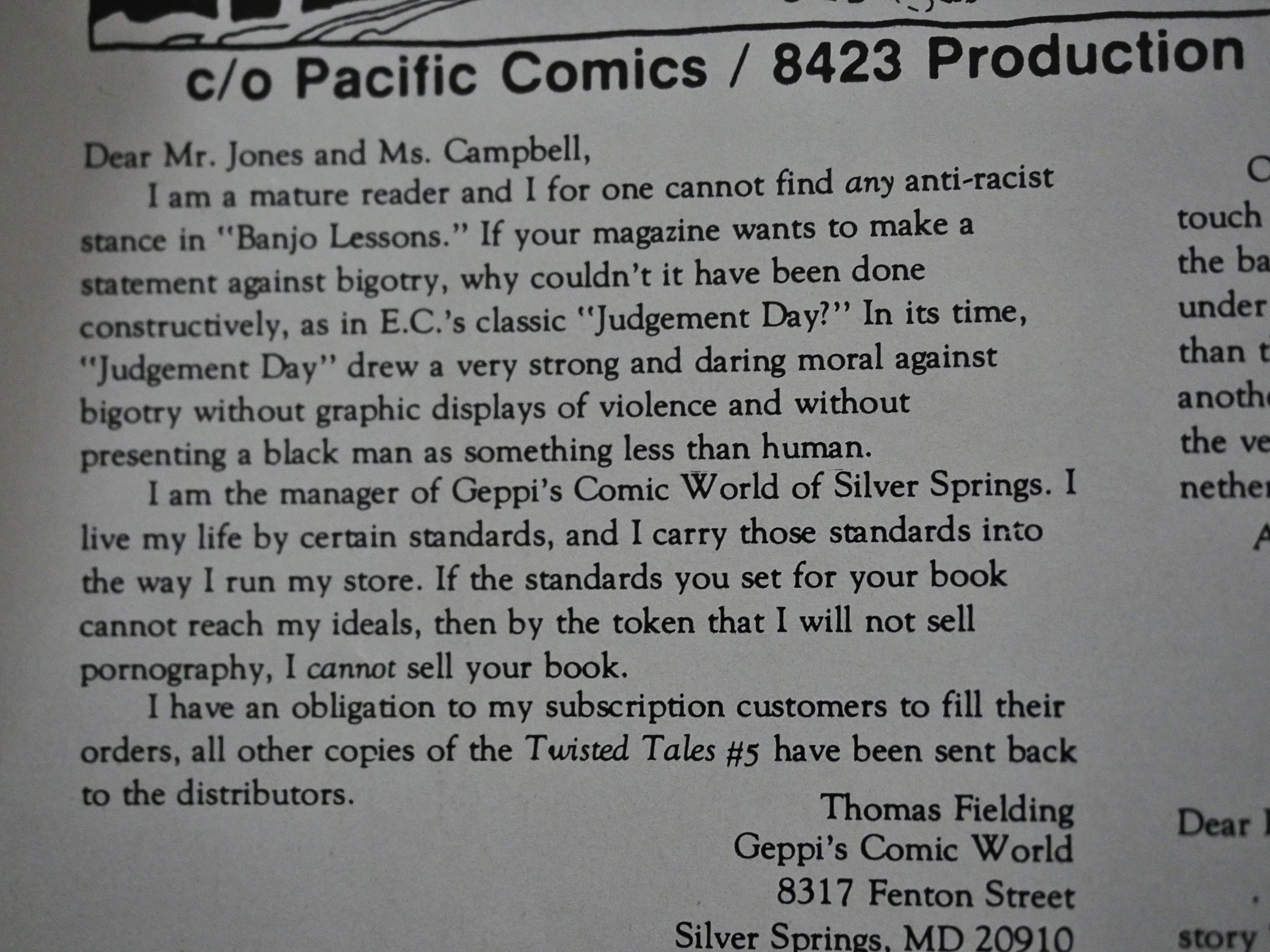
The reactions were, er… Mixed? Here we have one retailer that refused to sell the issue and returned it to the distributor.
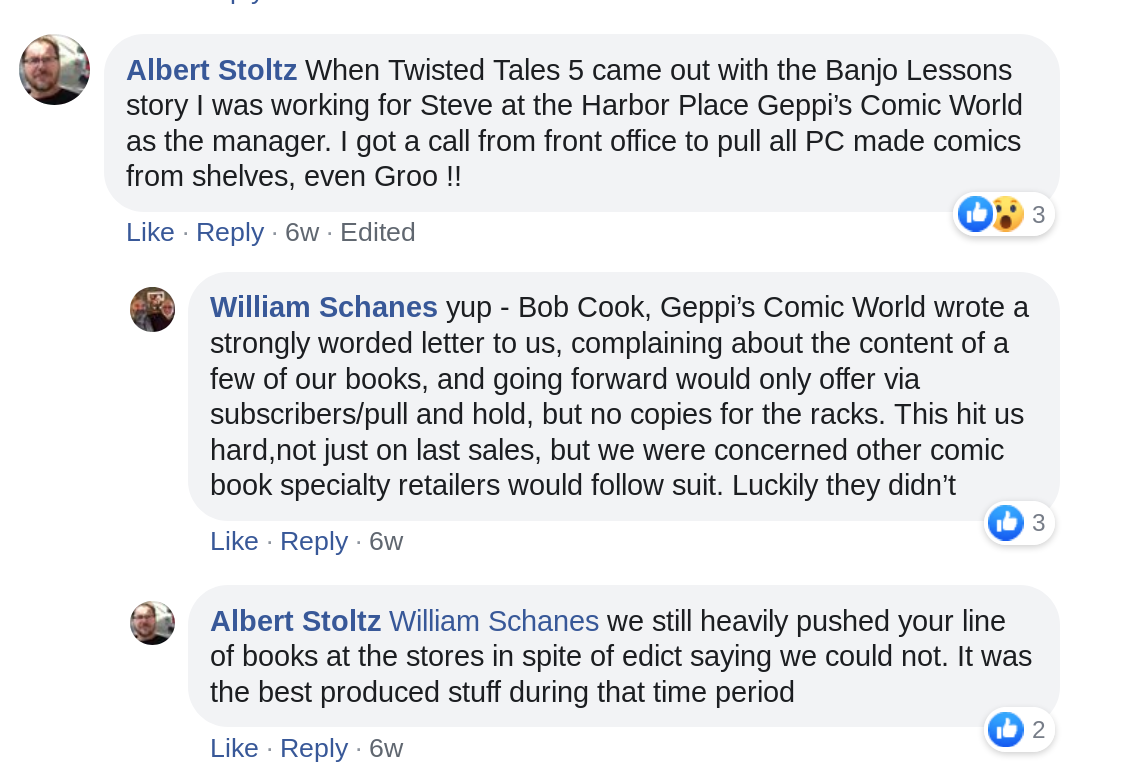
Steve Geppi was so angry with the story that he apparently ordered all Pacific Comics pulled from the shelves of his store(s).
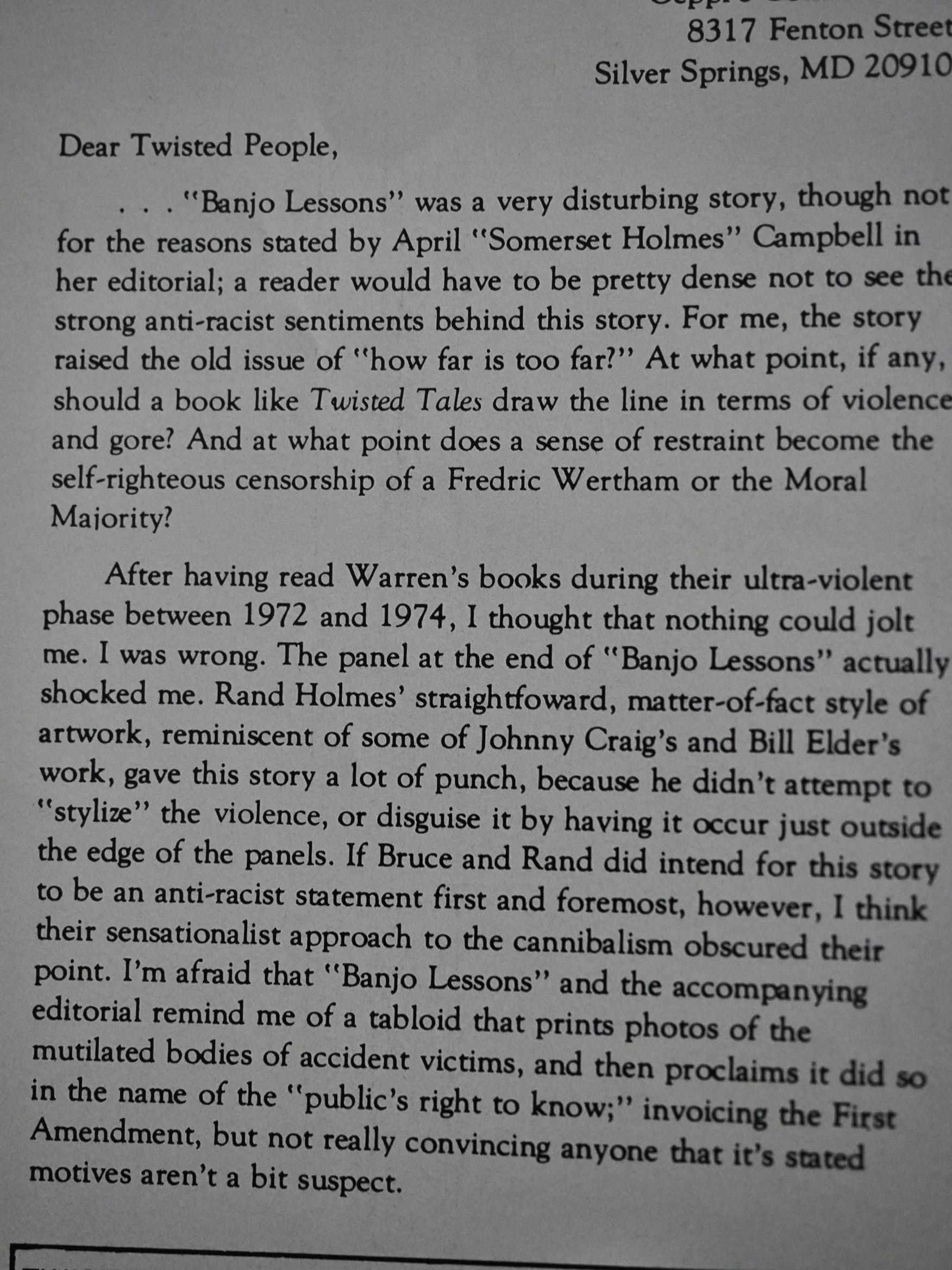
Another reader asks “how far is too far?”
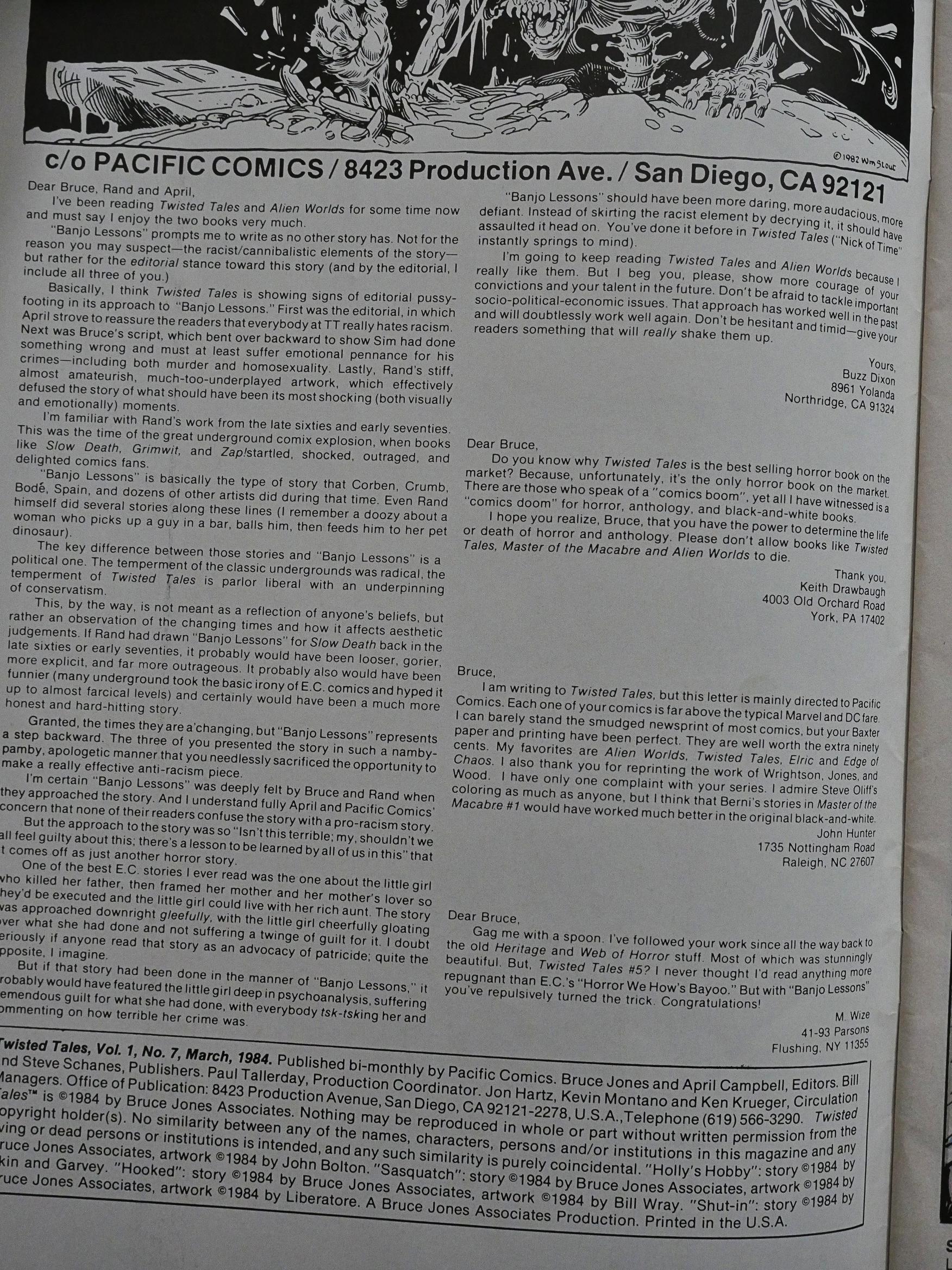
Chuck Dixon, on the other part, felt that there was something wrong, perhaps, er, it should have been grislier! Or funnier! Or less preachy! Or something! It’s almost like you feel it touched a button. Or something!
Banjo Lessons have never been reprinted in any collections as far as I can tell by googling for three seconds, not even in the Rand Holmes retrospective.
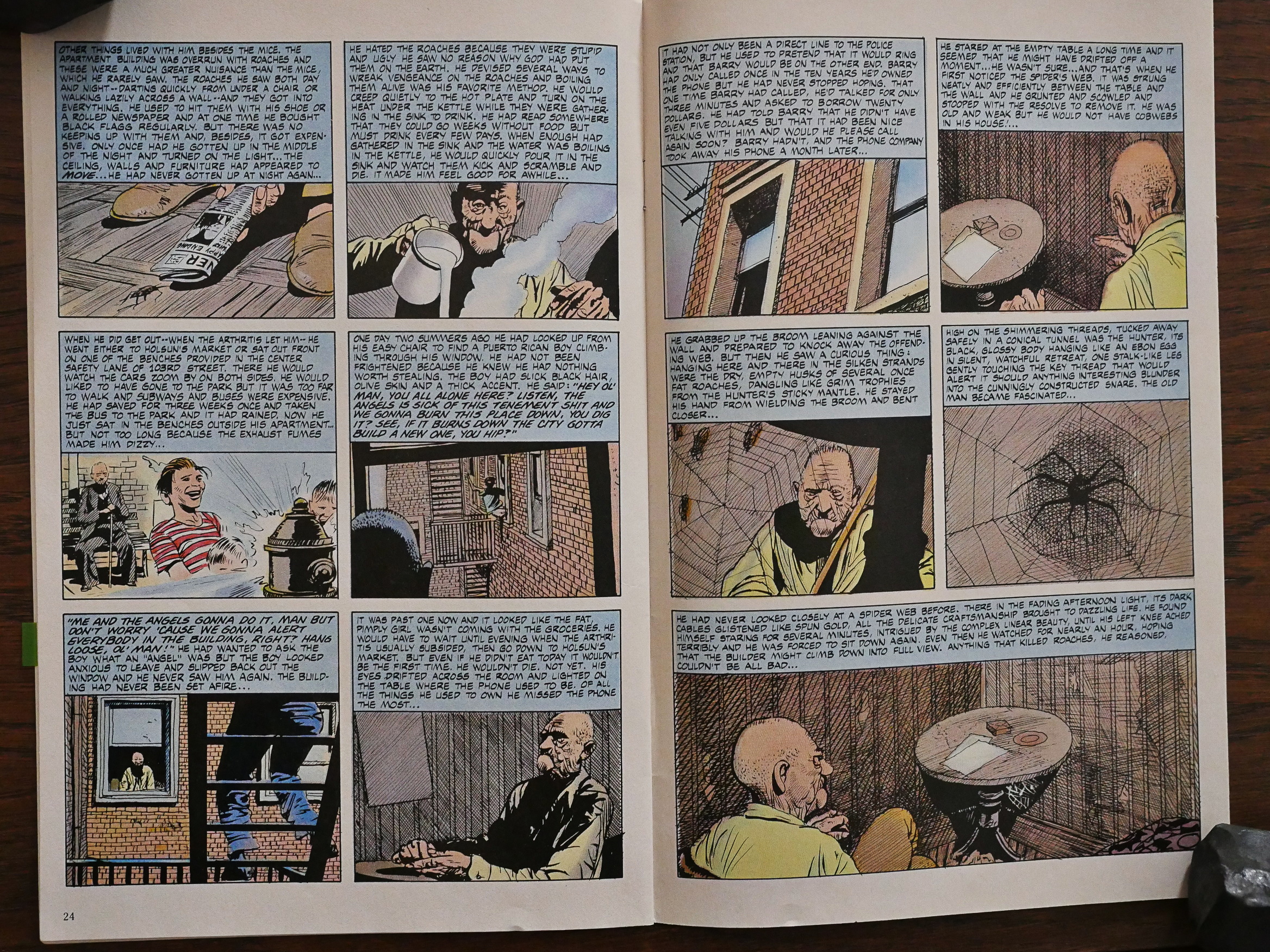
Roomers is probably my favourite story in Twisted Tales, strangely enough. When I turned the page to this Attillio Micheluzzi-illustrated piece now, I groaned inwardly “eeep! super-overwritten!” But it’s really not. It’s more of an illustrated short story than an overwritten comic, if that makes any sense. Jones writes an original and touching story with many small, sensitive and well-observed touches. Really quite wonderful and a major change of pace.
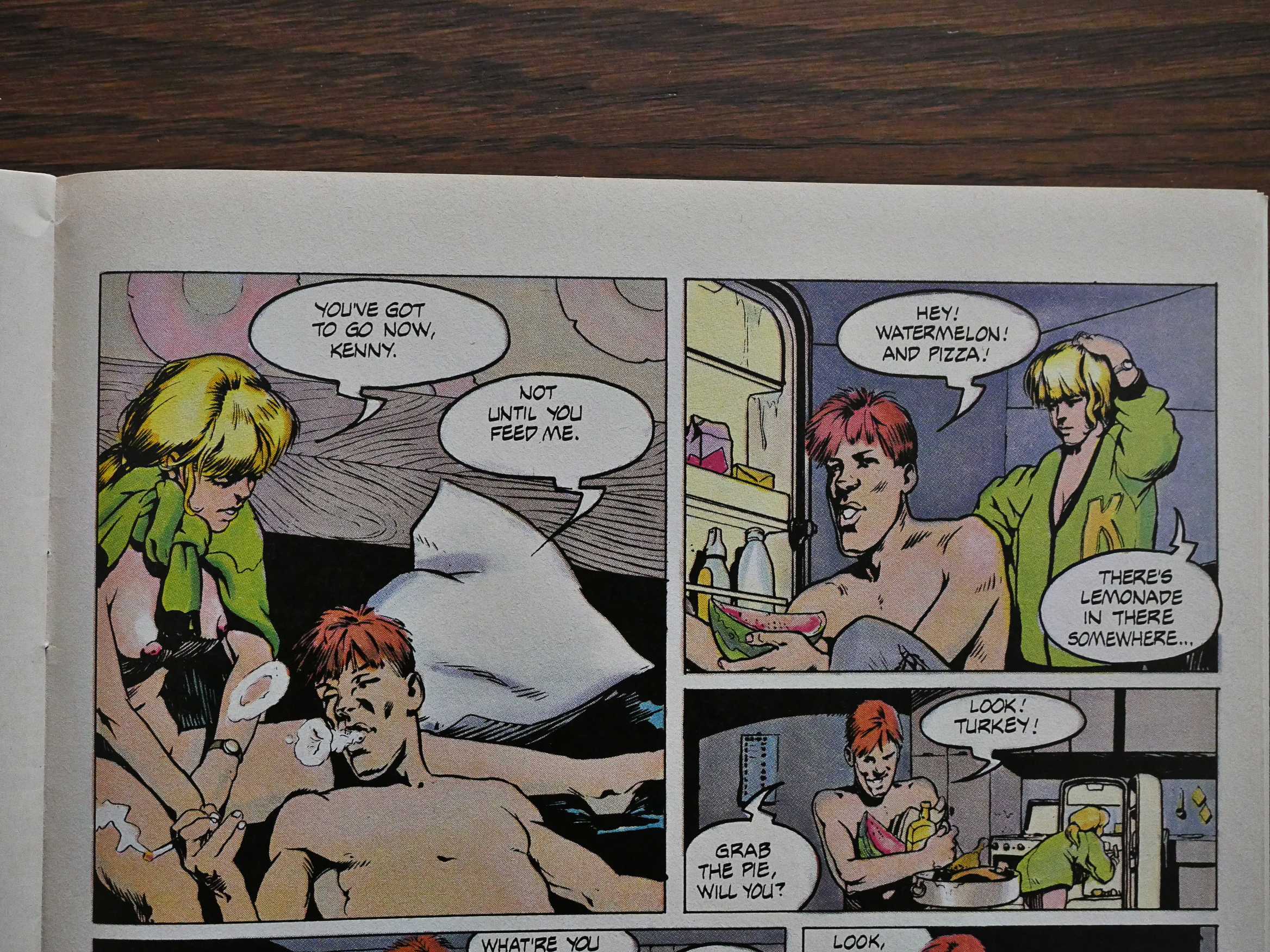
Micheluzzi’s not the only Italian illustrator who pops up: Here’s Tanino Liberatore of RanXerox fame, in another story that’s way twistier than you expect.
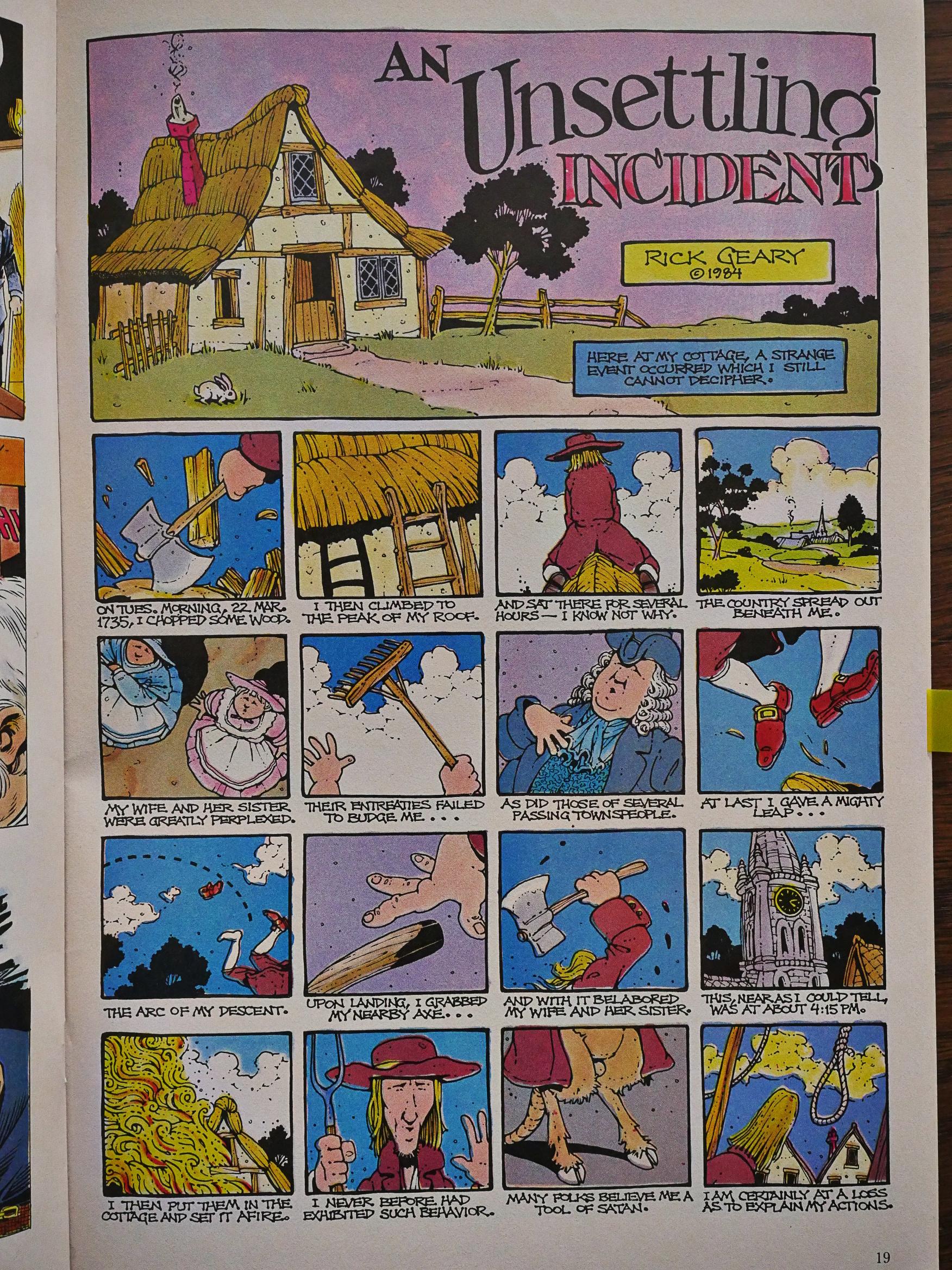
Hey! Rick Geary! You can never have enough Rick Geary, but he only does two of these one-pagers.
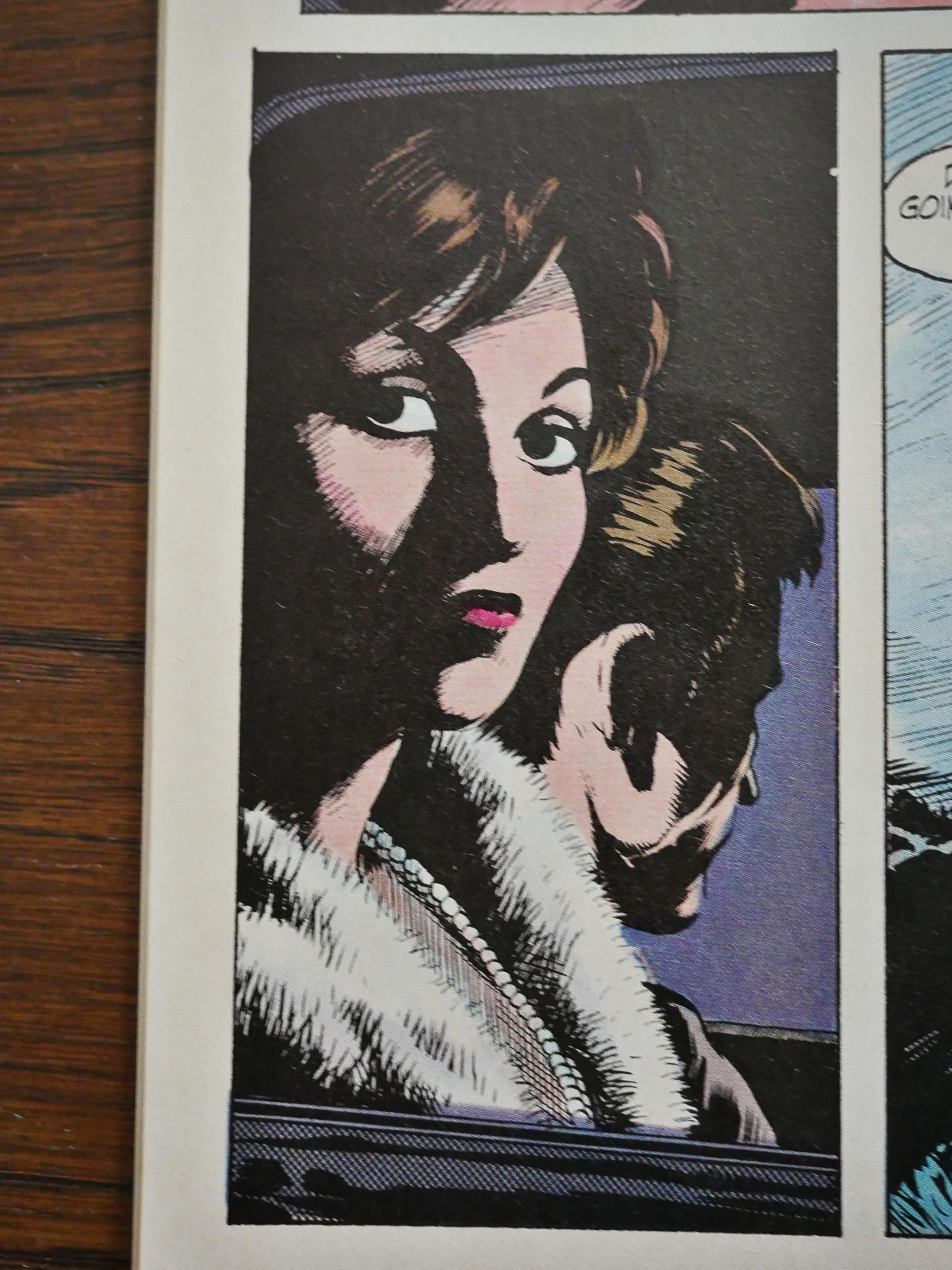
Most of the artists in Twisted Tales are pretty famous, but I’m not familiar with Mike Hoffman. He’s got a super-attractive inking style.
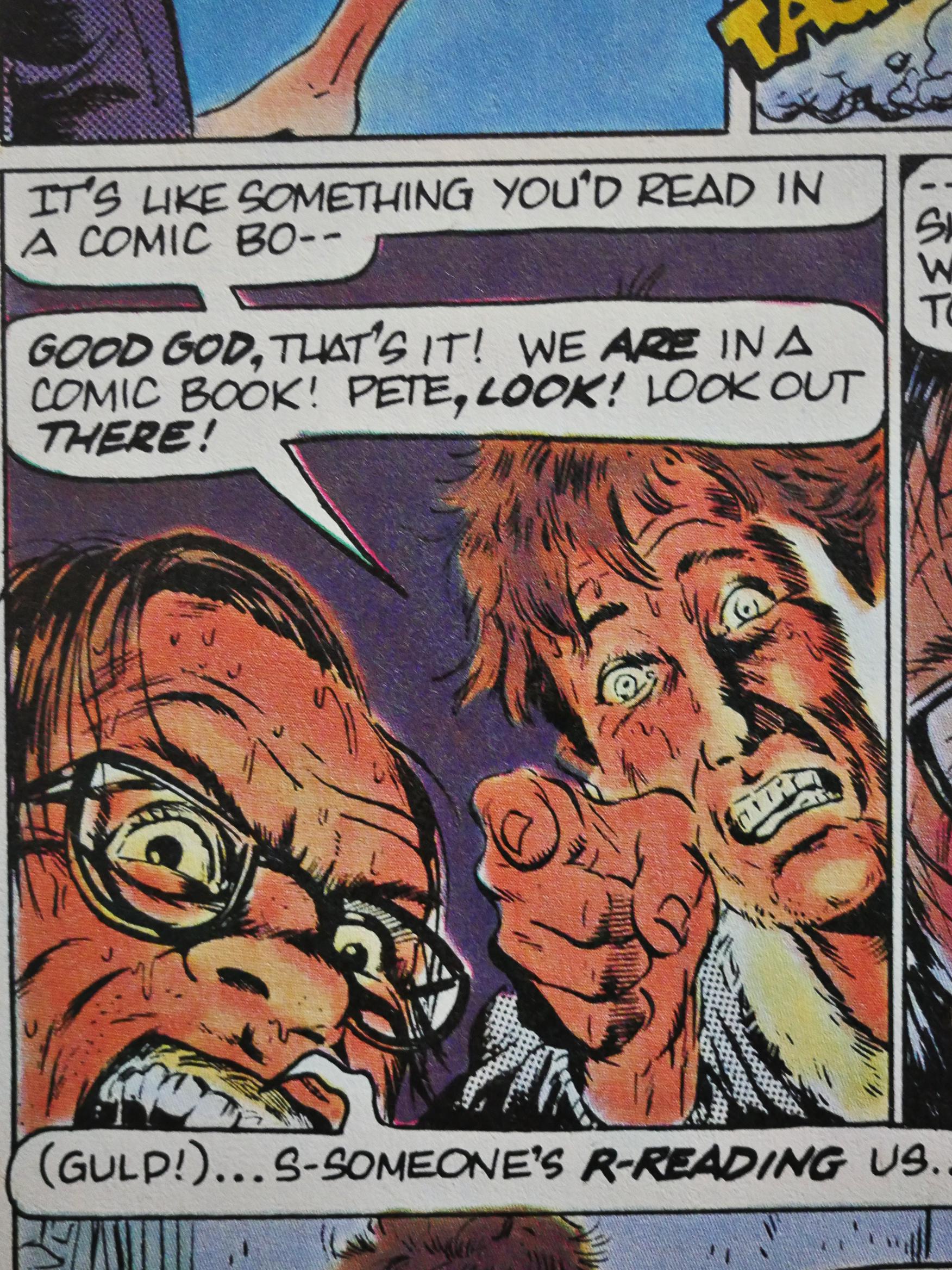
And then Pacific went under and Twisted Tales was picked up by Eclipse Comics.
As with its sister publication Alien Worlds, it only lasted two issues under the new regime, but I wonder whether the reason it was cancelled (and quickly replaced with Tales of Terror (which was not edited by Bruce Jones)) was not that Eclipse wanted to own the trademark (both Twisted Tales and Alien Words are owned by Bruce Jones Associates), but that Jones was burned out.
#9 of Twisted Tales has, for the first time (I think), somebody else writing the stories except Jones himself. The opening shot, illustrated by Thom Enriquez, is a story about a writer with a writing block (sort of), which is usually a sure sign that the writer is out of ideas.
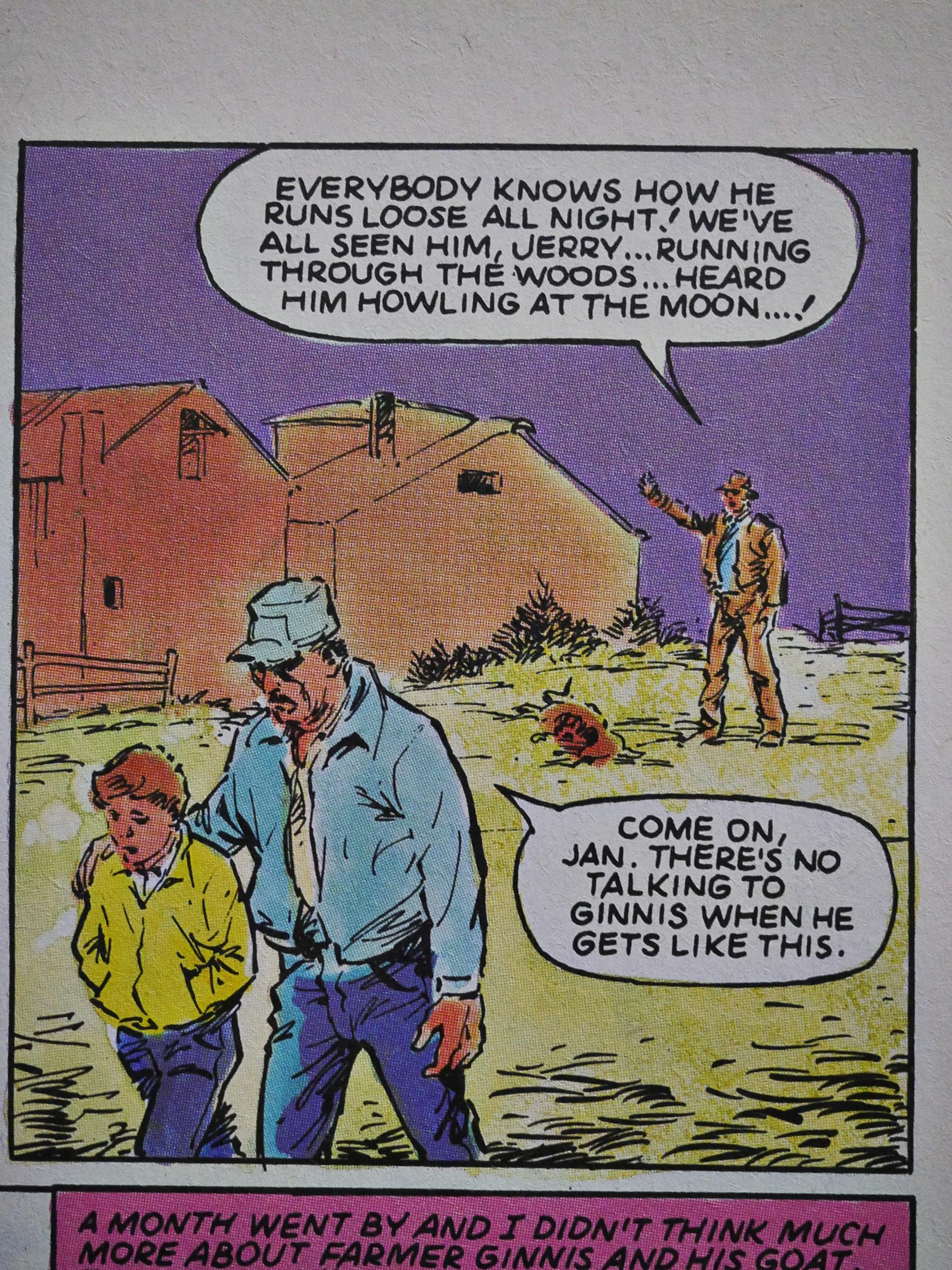
Jan Strnad writes this (allegedly true) story illustrated by Val Mayerik, for instance.
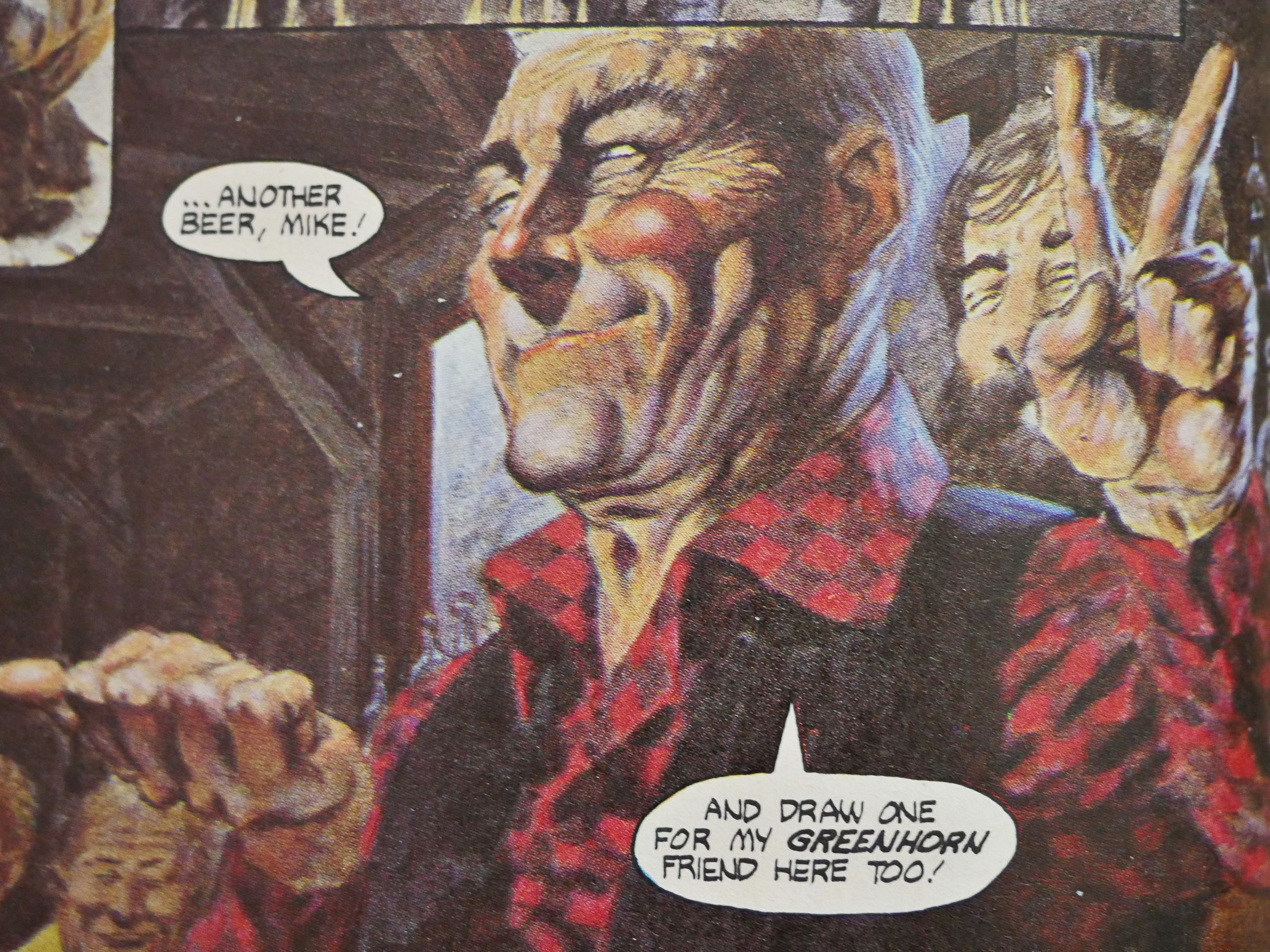
But then, in the final issue, almost all the stories are written by Jones again. And he’s even enticed Berni Wrightson to come back and illustrate a short yarn.
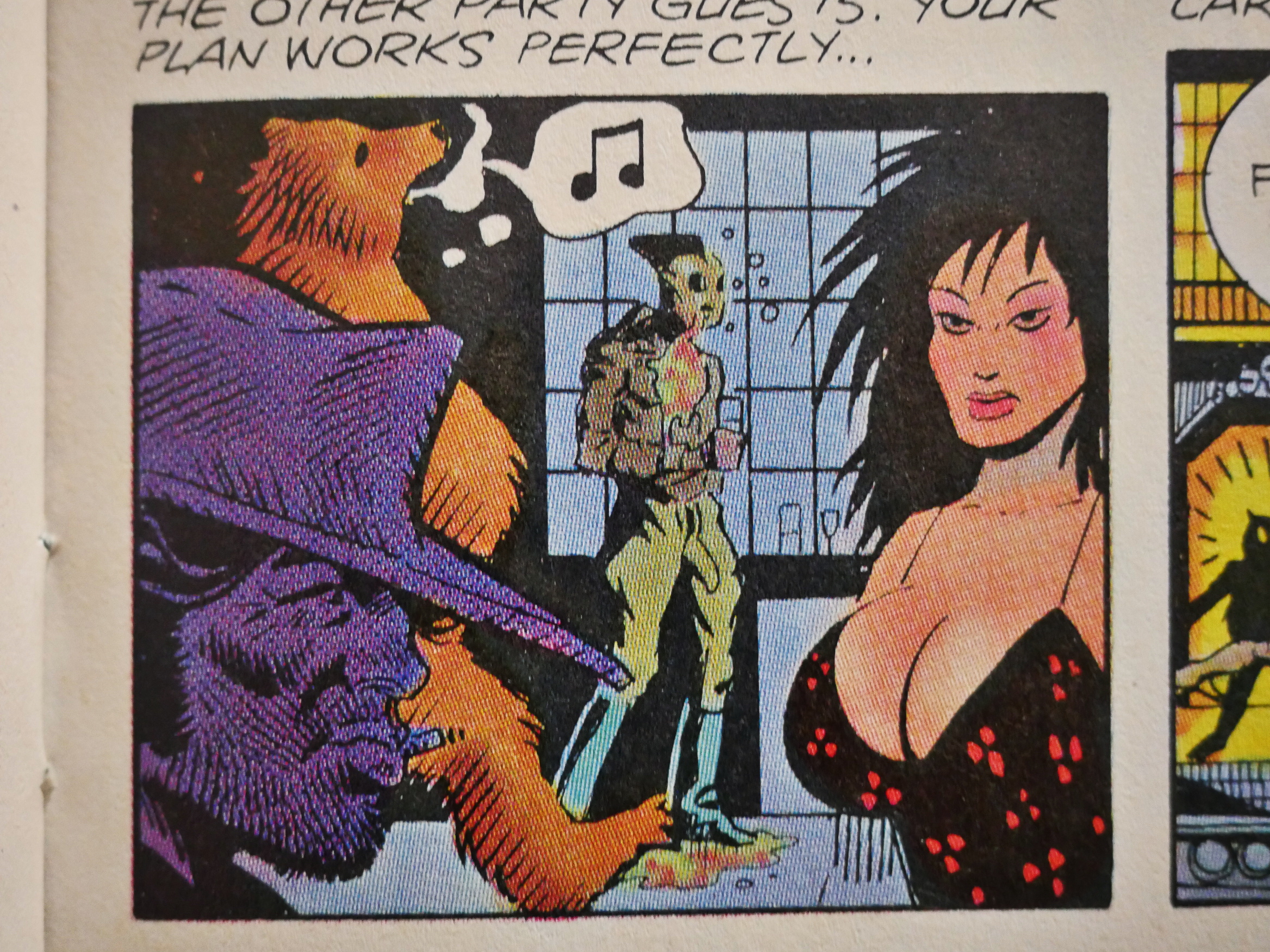
Bill Wray draws a scene from a party featuring some very recognisable characters. See how many you recognise!
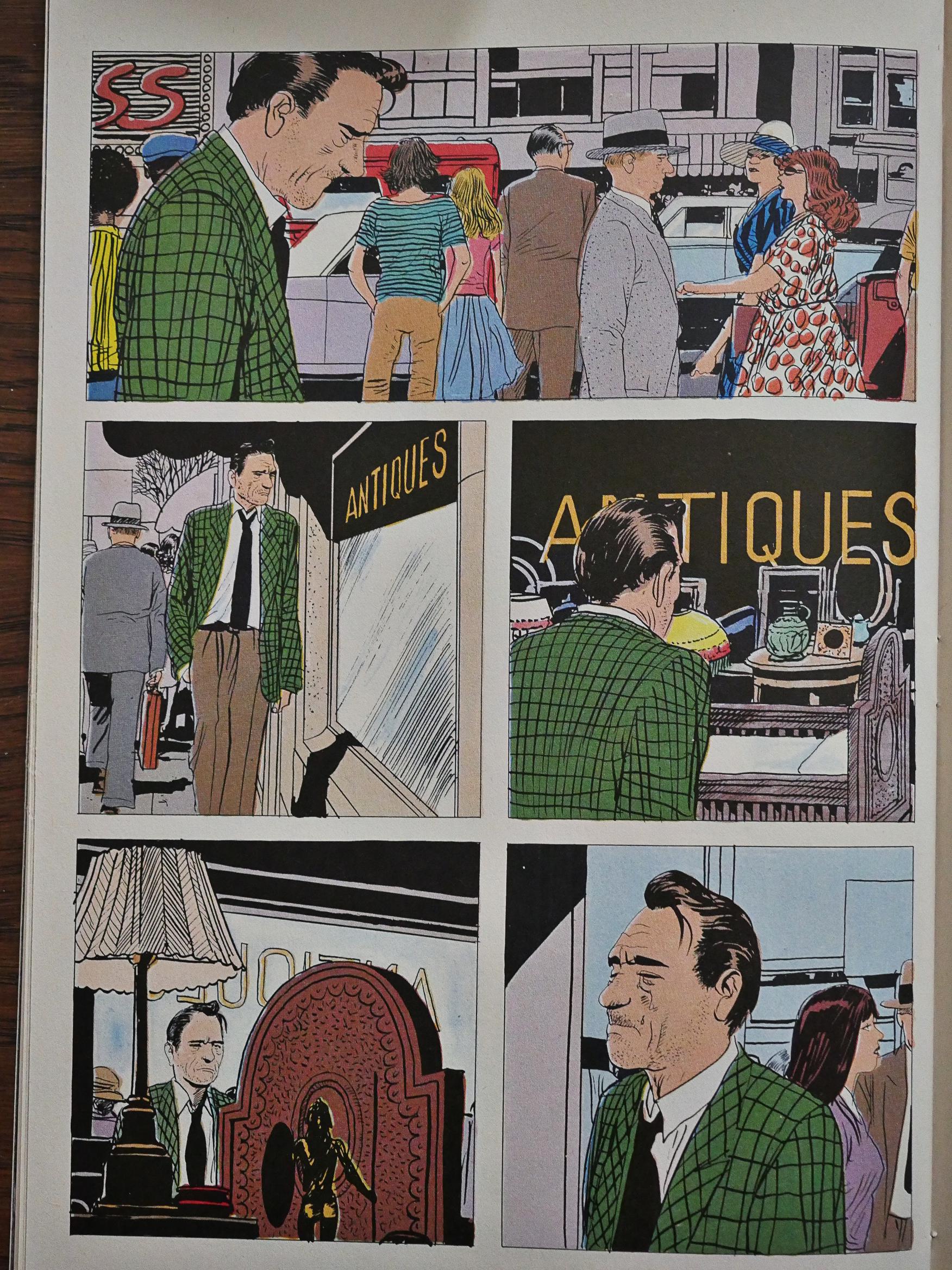
Perhaps as an apology for the previous text-laden story that Attillio Micheluzzi drew, David Carren writes a story for him with very little text to obscure his very Italian and sharp artwork.
And then it’s over. As far as I can tell, few of the stories here were reprinted beyond appearing in French and German anthologies concurrently to appearing in the US comics. Of all the missing reprinting projects, that’s perhaps the weirdest: I think there’s only a couple of duds among all these stories. They’re extremely entertaining and genuinely surprising, many of them, not formulaic hackwork like you’re used to reading in EC-influenced horror anthologies.
But perhaps it’s a rights issue? All the artists own the copyrights themselves. But on the other hand, why would the object en masse? Makes no sense. And there’s always a market for horror anthologies. Just imagine a slightly larger-sized collection of this stuff with excellent printing…
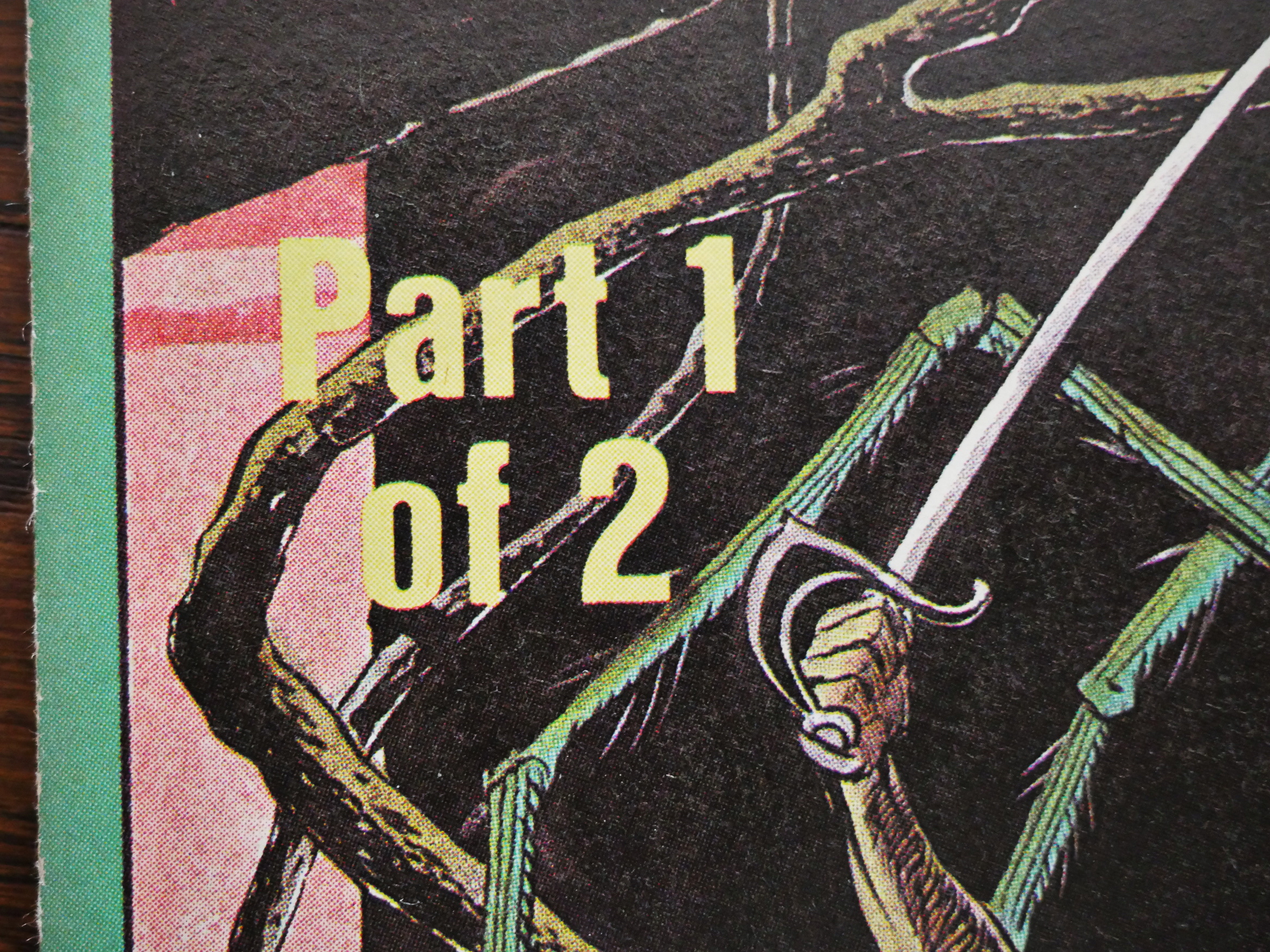
But speaking of reprints, here we’ve come to The Twisted Tales of Bruce Jones, where the first issue’s cover proclaims that it’s a two issue micro-series, and then goes on for four issues.
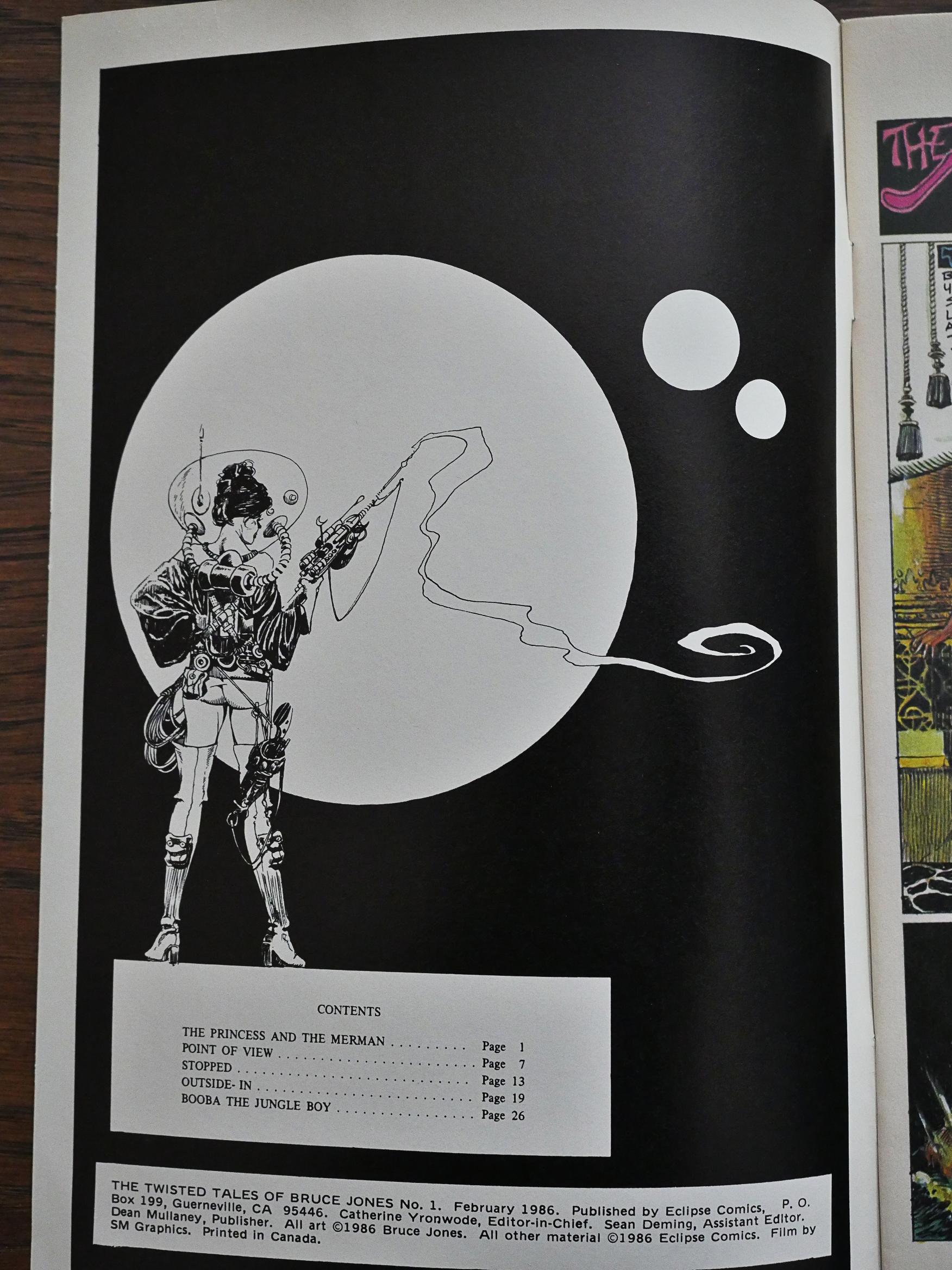
Jones usually has no problem putting words to paper, but there’s no explanation what-so-ever about what we’re about to read here.
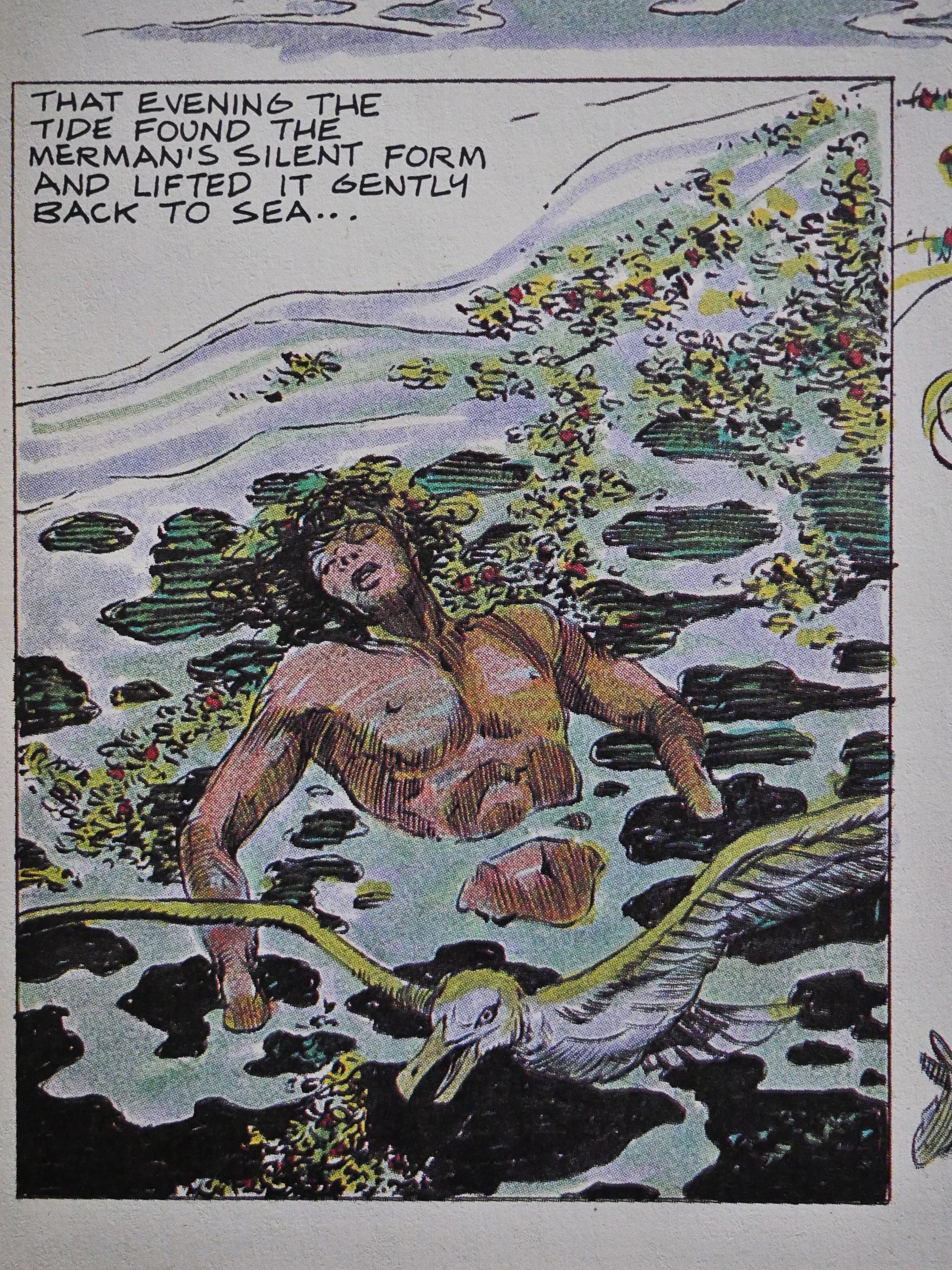
And it turns out to be three (perhaps) new stories written and drawn by Bruce Jones, and the rest are reprints from the late 60s/early 70s.
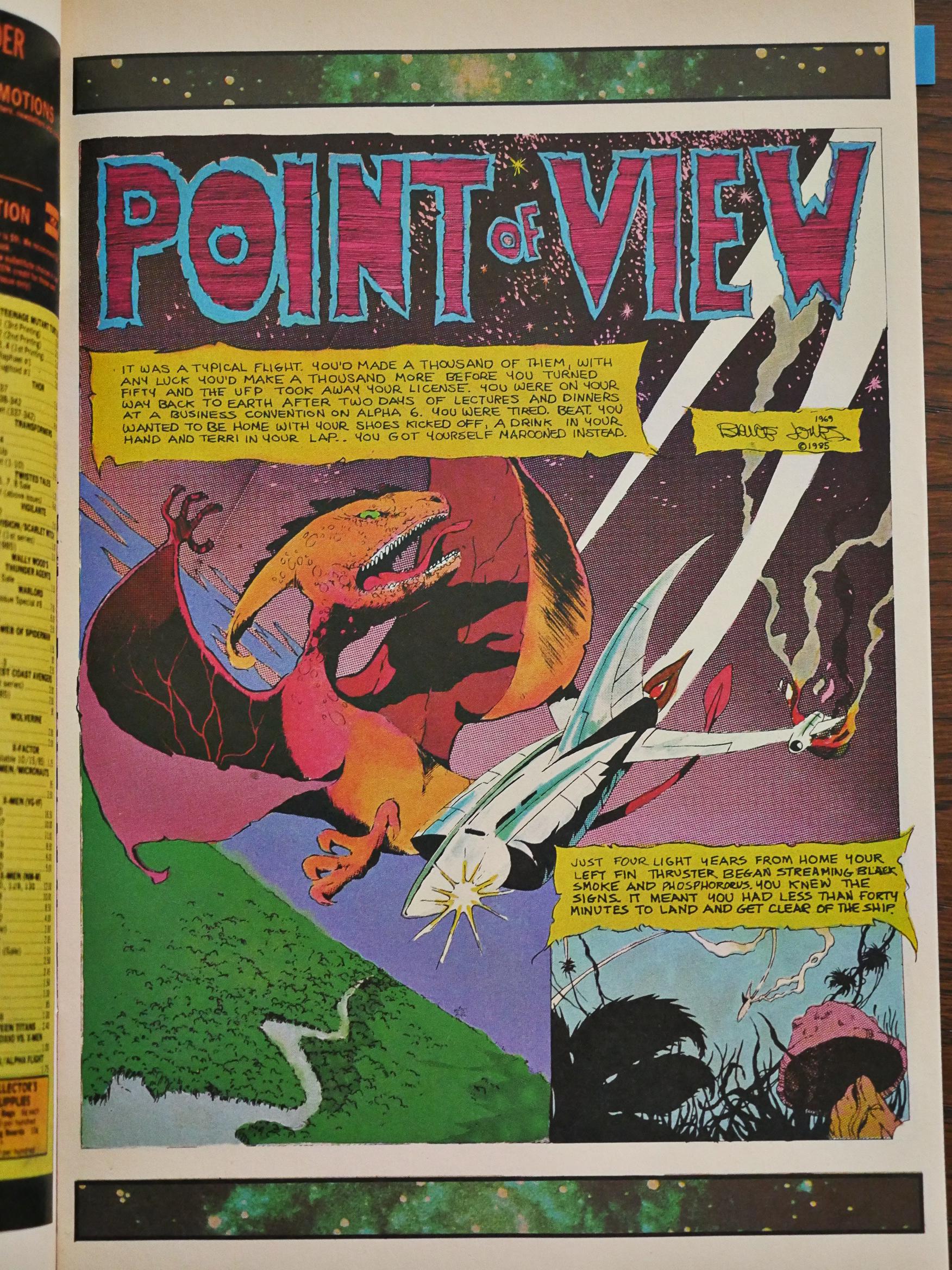
This one mentions both 69 and 85, so perhaps some of these were reworked a bit before publication?
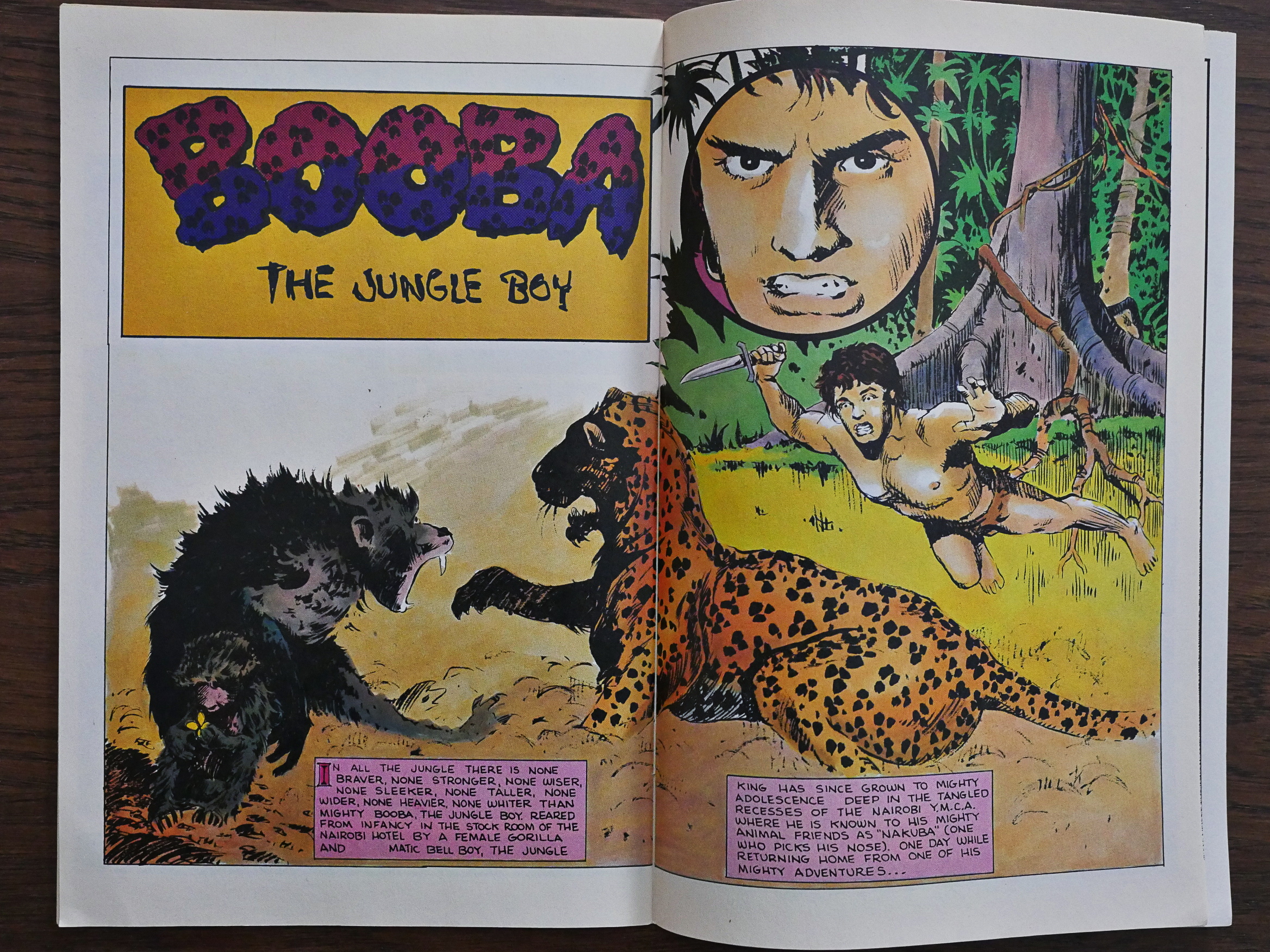
In any case, these are basically early pieces that have probably never been published professionally. At least comics.org doesn’t have any record of them being published… perhaps they appeared in fanzines?
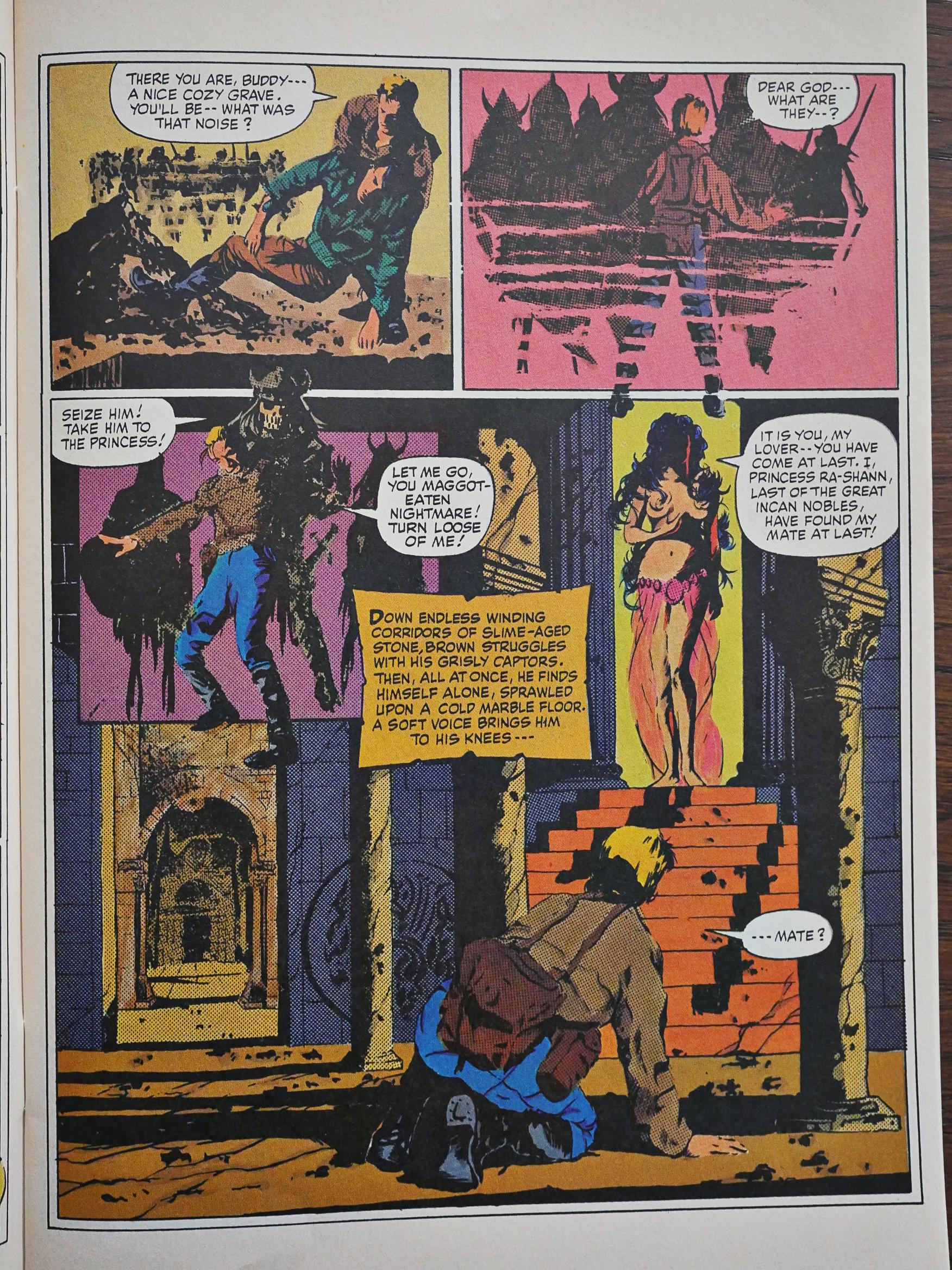
While Jones would later become a very accomplished writer, he isn’t here. All the stories are basically twaddle.
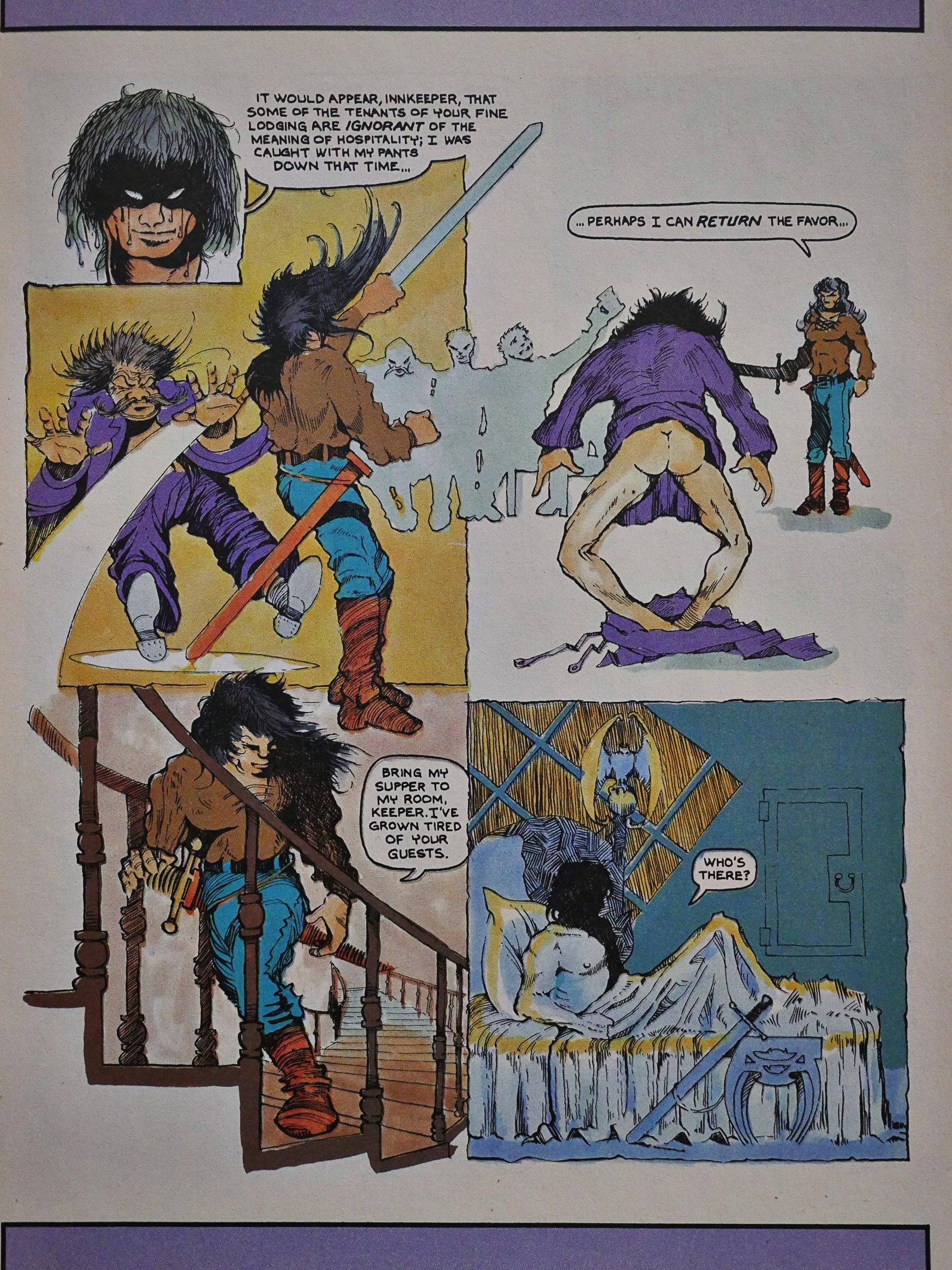
The artwork veers between trying to be Frank Frazetta and trying to be Vaugh Bodé, which are both fine aspirations.
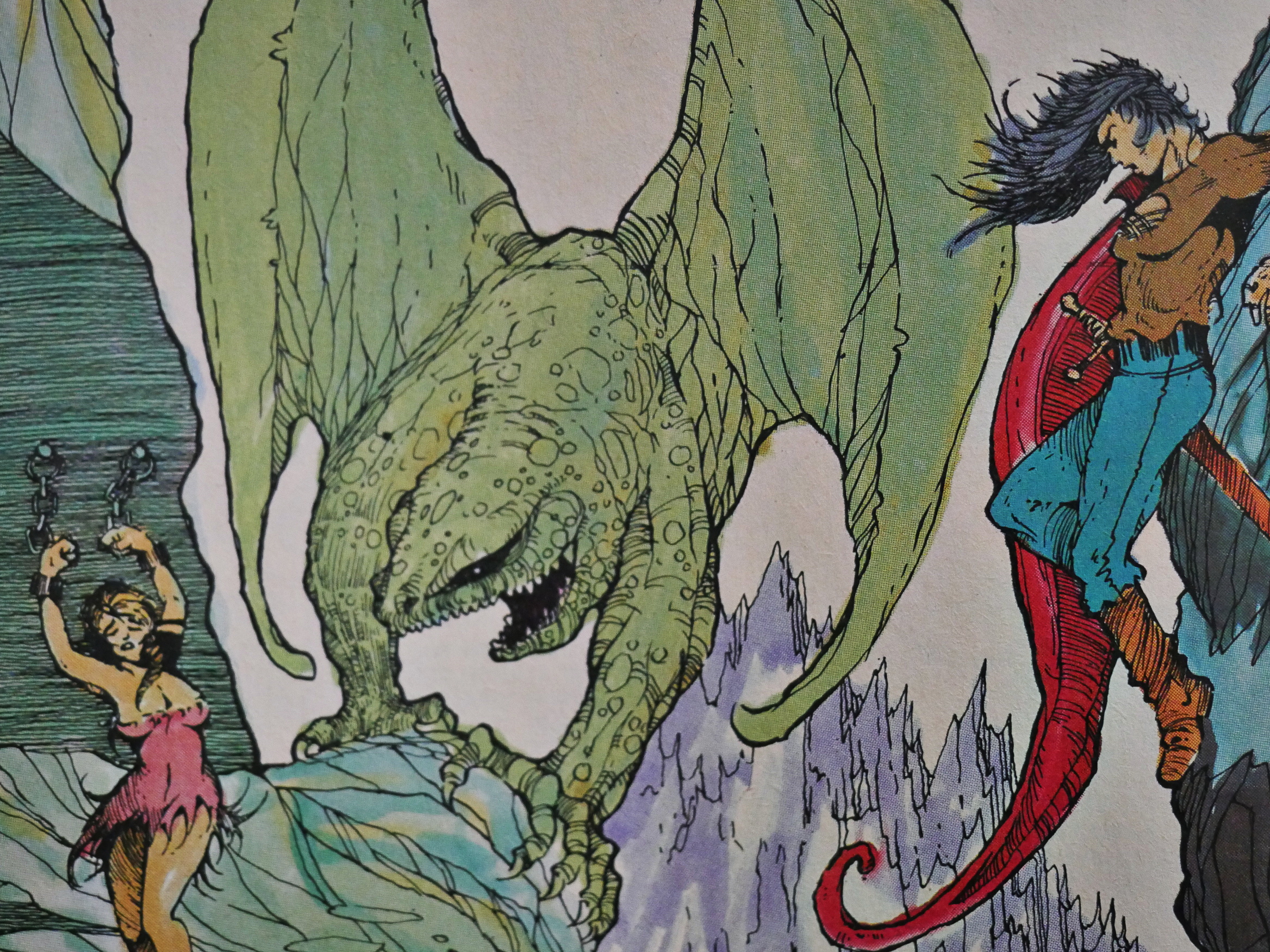
Sometimes the artwork’s so wrong that it’s right.
This series was apparently published on a weekly basis during February 1986, presumably so that (due to the long lead time for ordering comics on a non-returnable basis to comics store) orders would have to be locked in for all four issues before any retailer saw the first issue.
If so: Well played. Too bad for the retailers that presumably had to eat their stock of #2-4 for breakfast the next few years.
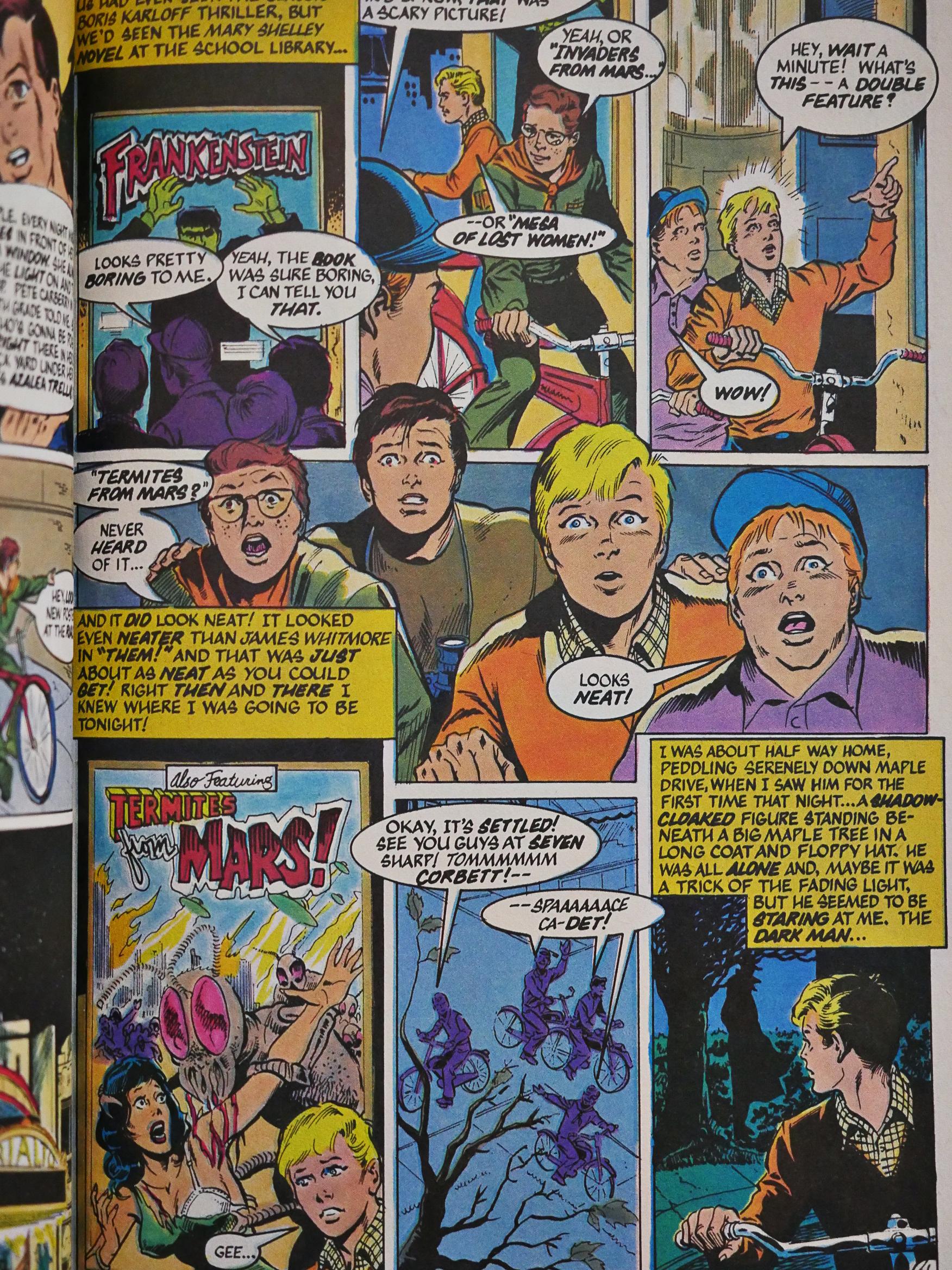
And finally, a year and a half later, Jones returned with the all-new Twisted Tales anthology, which was supposed to continue on a regular basis in a squarebound “prestige” format.
It’s very different from the original run. Despite being longer, there’s only three stories here, and the first one (seen above, ineptly drawn by Rick Stasi and Jim Mooney) takes up most of the space. It’s about growing up in the 50s and friendship and that kind of stuff, and isn’t very horrible. Perhaps the style of artwork here is appropriate for this sort of tale, it’s still fucking boring to look at.
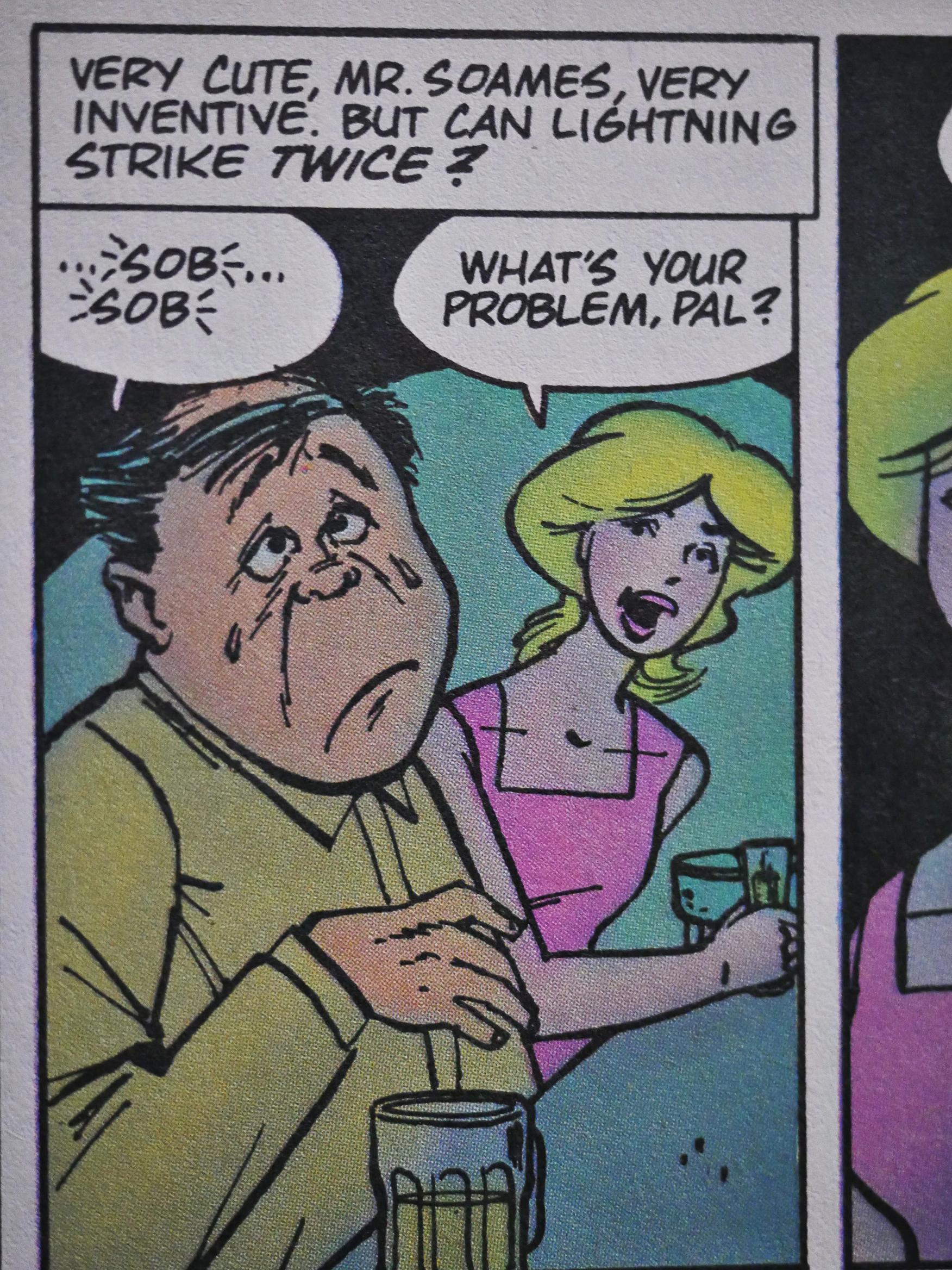
Scott Saveedra does the artwork on one of the backup stories. And he’s also a strange choice, but at least his artwork’s kinda amusing.
And… that’s it. I loved reading the ten issues of the original run.
But what did the critics think? Hm… Heh, just stumbled onto this by Paul Wardle i The Comics Journal #97:
A case in point is DNAgents. I have never paid much attention to this title until a friend of mine who works in a comic shop pointed out to me why the book is known sarcastically as T&Agents. Not only are the characters shown in a variety of suggestive positions in almost every panel, including an exorbitant number Of crotch shots, but the characters in question are supposed to be teenagers between the ages of 13 and 16! This book borders on being comicbook kiddie-porn.
No, it’s not about Twisted Tales, but instead about T&Agents. I mean DNAgents. He’s got a point.
Hm.. Let’s see… Here’s Michael Now from #90, from an article called “Comics In The EC Mold Or Just Moldy Comics”.
Sorry, but I have to quote a bit more than usual:
With the appearance of TT#1, my hopes weren’t altogether dashed, but let us say they were dented a bit. The ending of the first story, “Infected,” drawn by Richard Corben, where the woman’s “crabs” turned out to be some absurd form of mutated man-eating land crabs, should have been the tip-off, but remained, optimistic, hoping that the next Story would be better, and the one after that, better still. What a chump I felt like by the end of the comic.
[…]
Aside from the needless nudity, I saw another unfortunate pattern in Jones’s stories: few of them made any solid sense.
[…]
Even “Banjo Lessons” by Jones and Rand Holmes, also in #5, which appears to a Sincere attempt at an anti-racism story, is too obviously derivative Of Al Feldstein’s and Wally Wood’s similar stories in Shock Suspenstories to say anything new. Still, I must admit that this is probably Jones’s best Twisted Tales story to date, with only the Rand Holmes story in “Speed Demons, coml ng anywhere close.
[…]
The following story, rather badly drawn by Don Lomax (who has, appropriately enough, drawn comics for Hustler, and whose work I disliked when I saw it a few years ago in a magazine called Gasm, an illfated Heavy Metal rip-off) is even worse. The story is built around two women clad only in underwear with knives held to their throats, and having fingers and ear lobes carved off. The twist ending reveals that the women are actually lesbian lovers getting rid of their husbands.
I guess these girls never heard of divorce.
I found this story to be particularly vile. It angered me to see Jones not only use the female form, but homosexuality as well, as nothing more than lame, unimaginative, reader as well as disrespectful and insensitive to women and homosexuals as equal members Of the human race. One must wonder, what does Bruce Jones have against women? Perhaps only a skilled therapist can answer that question.
[…]
What form of diseased “adult” are these comics supposed to appeal to?
Well! I never!




















































